A post by Ovi at peakoilbarrel
All of the oil (C + C) production data for the US states comes from the EIAʼs Petroleum Supply monthly PSM. After the production charts, an analysis of three EIA monthly reports projecting future production is provided. The charts below are updated to June 2020 for the 10 largest US oil producing states.
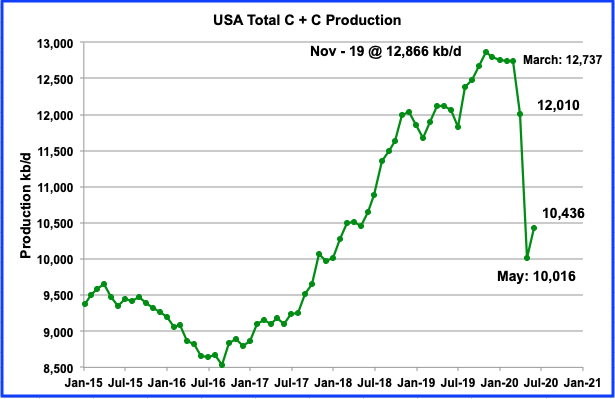
June’s production rebounded from May’s low by adding 420 kb/d. May’s output was revised up by 15 kb/d from the EIA’s July report.
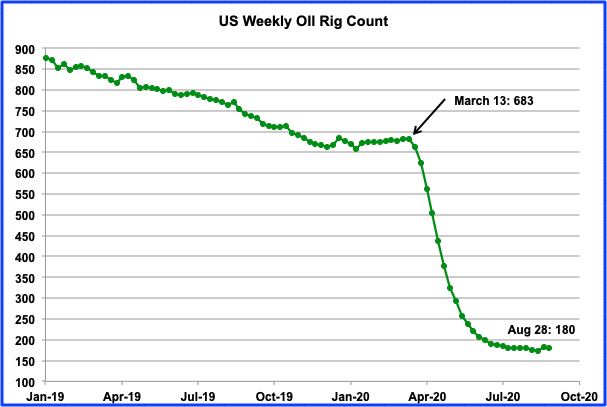
After adding 11 rigs in the week of August 21, the US rig count dropped by 3 in the week of August 28 to 180. Two of the 3 rigs were parked in the Permian.
RANKING PRODUCTION FROM US OIL STATES

Listed above are the 10 states with production previously greater than 100 kb/d. Over the last few months, both Utah and Louisiana fell below 100 kb/d but are retained for continuity. These 10 accounted for 8,501 kb/d (81.5%) of US production out of a total production of 10,436 kb/d in June 2020. Note that of all these 10 states, only New Mexico produced more oil in June than in the same month last year. On a YOY basis, US June production was down by 1,624 kb/d.
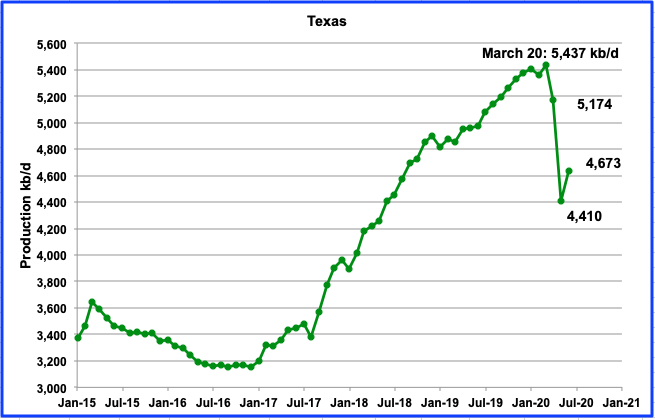
Texas production increased by 263 kb/d to 4,673 kb/d in June, an increase of 6%. This is less than half of May’s decline of 764 kb/d.
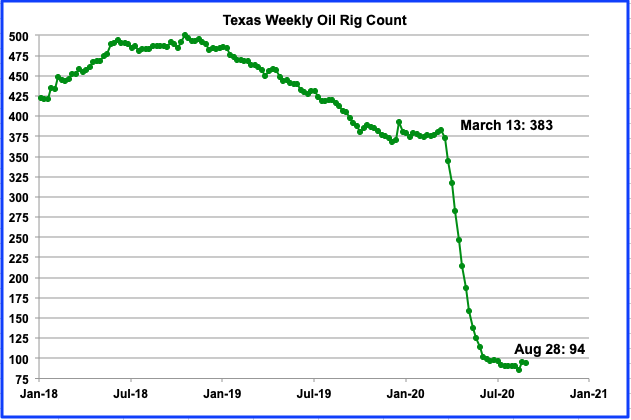
From March 13 to August 28, the Texas oil rig count dropped by 289 to 94 or 75.5%. An output drop followed in April and a larger one in May as shown in the previous chart. However while rigs continued to drop in June production did rebound as shown above.
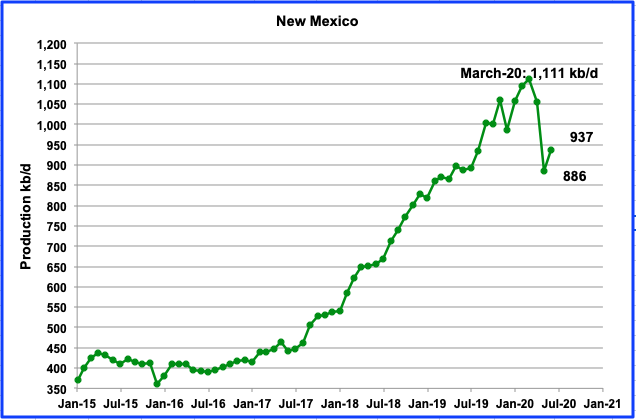
June’s New Mexico production increased by 51 kb/d to 937 kb/d. New Mexico has now passed North Dakota to become the US’ second largest producer
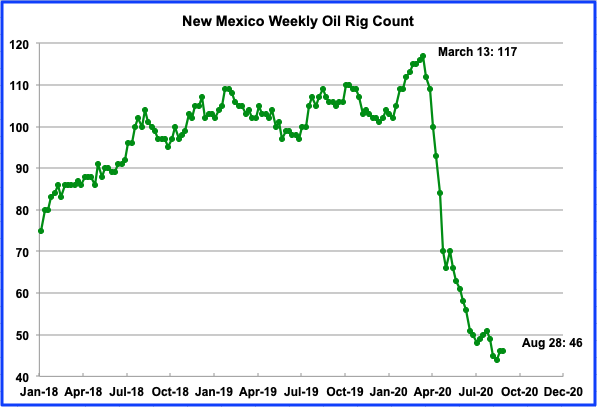
From March 13 to August 28, New Mexicoʼs rig count dropped by 71 or 61%. Over that same period, production dropped by 21%. Even though they dropped in June, June production increased.

North Dakotaʼs oil production started to drop in November 2019 after peaking at 1,480 kb/d in October. In May output declined by 357 kb/d to 864 kb/d and then only added 8 kb/d in June to 872 kb/d..
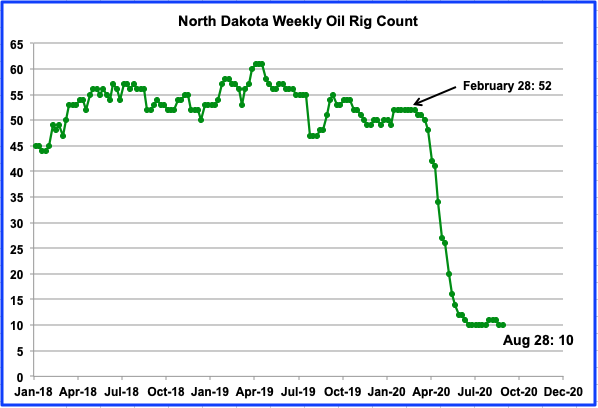
The North Dakota rig count has held steady at 10 for the weeks of August 21 and August 28.

Oklahomaʼs output peaked in April 2019. From a low of 361 kb/d in May, production rebounded in June 2020 by 102 kb/d to 463 kb/d. Oklahoma had 10 oil rigs in operation from the week of Aug 14 to August 28. In January they had 50 oil rigs operating.

Colorado, after showing a small production increase in April, dropped by 23 kb/d to 471 kb/d in May and then dropped to 450 kb/d in June. Coloradoʼs oil rig count has held steady at 4 for the last 10 weeks.
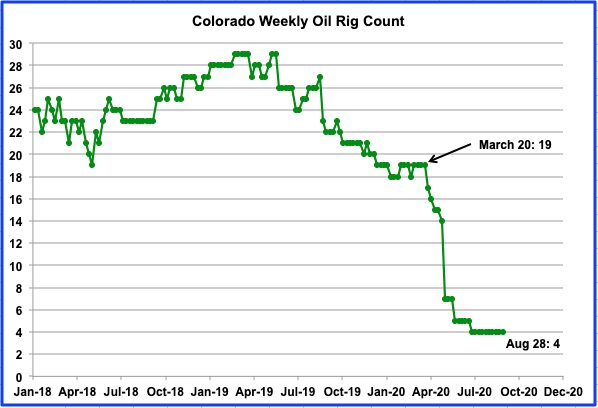
Coloradoʼs oil rig count has been 4 for the last 10 weeks.

Californiaʼs slow output decline has accelerated in the last few months and dropped below 400 kb/d. June production was down by 4 kb/d to 392 kb/d and is giving an indication of slowing decline. During the last 10 weeks, California had only 4 rigs operating.
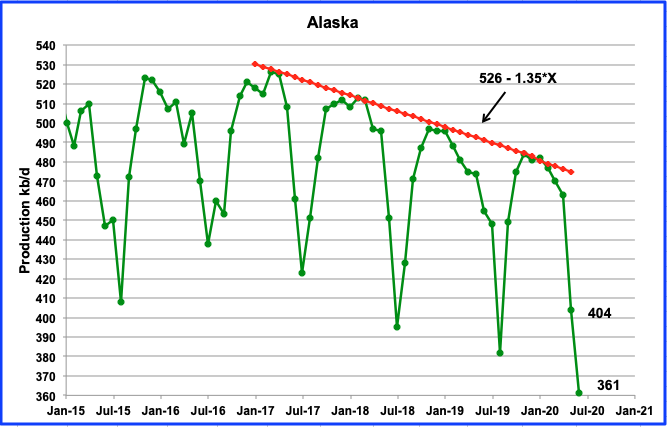
Alaska production continues its annual summer decline. In June output dropped by 43 kb/d to a new low of 361 kb/d. This is 21 kb/d lower than the August 2019 output of 382 kb/d.
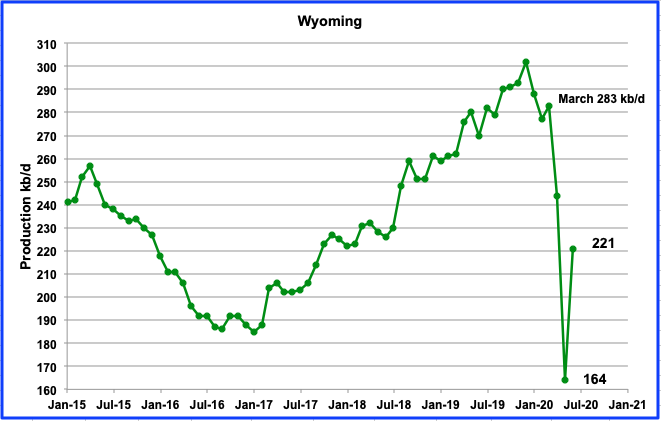
Wyomingʼs production in June increased by 57 kb/d to 221 kb/d. During the week ending August 28, Wyoming had 1 oil rig in operation, down from a high of 20 in January 2020.
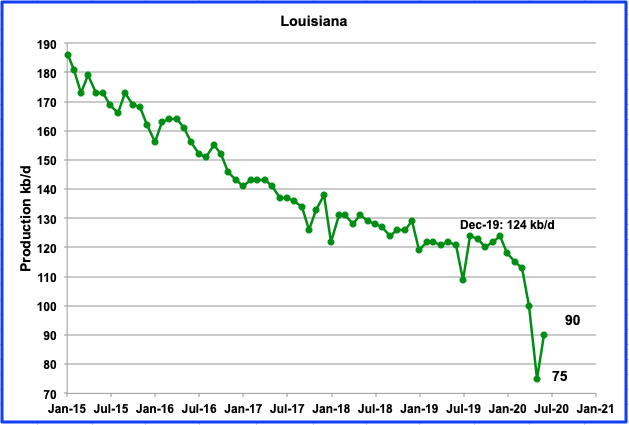
Louisianaʼs output began its steady decline in January 2020. However in June production rebounded by 15 kb/d to 90 kb/d. In January 2020, on average, 22 oil rigs were operating. There were 11 oil rigs operating during the weeks of August 14 to August 28.
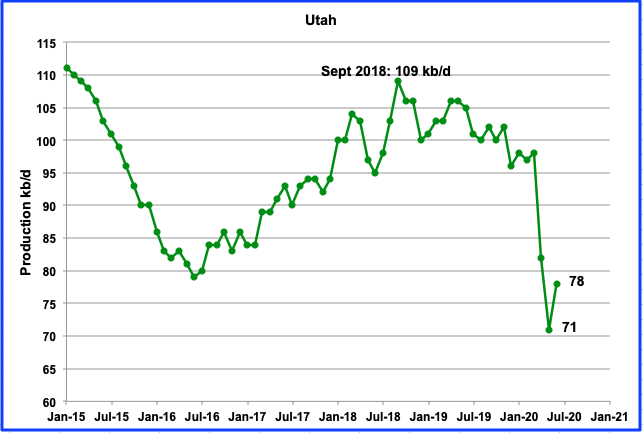
Utah’s output has been in an overall decline since September 2018 when it was 109 kb/d. The production bottomed in May 2020 at 71 kb/d and rebounded to 78 kb/d in June. There were five oil rigs operating in Utah during the weeks of August 21 and 28.
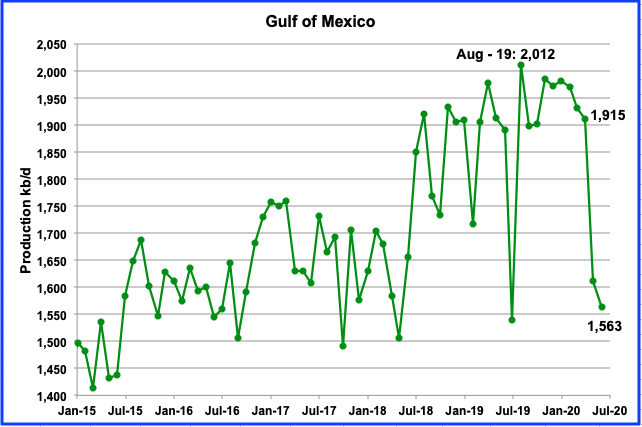
In June the GOM’s production continued to decline by another 49 kb/d to 1,563 kb/d. If the GOM were a state, its production would rank second behind Texas.
UPDATING EIA’S THREE OIL GROWTH PROJECTIONS
1) DRILLING PRODUCTIVITY REPORT
The Drilling Productivity Report (DPR) uses recent data on the total number of drilling rigs in operation along with estimates of drilling productivity and estimated changes in production from existing oil wells to provide estimated changes in oil production for the five principal tight oil regions. The charts are updated to September 2020.
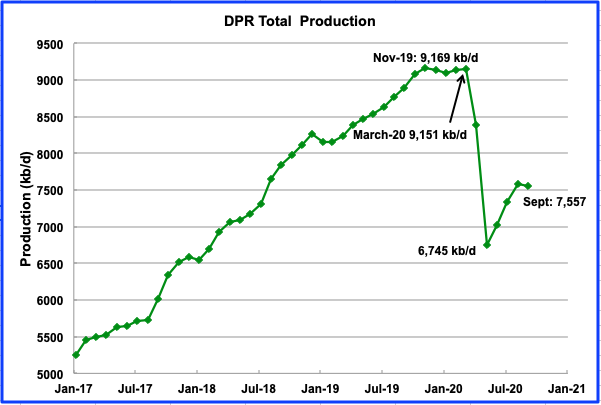
Above is the total oil production from the 7 basins that the DPR tracks. Note that the DPR production includes both LTO oil and oil from conventional wells/fields.
According to the August DPR report, LTO oil and conventional oil output peaked in November 2019 at 9,169 kb/d. The projected output in September 2020 is 7,557 kb/d, down 20 kb/d from August. Note that the August output was revised up from 7,490 kb/d to 7,577 kb/d. The biggest drop occurred in May, when production dropped by 1,646 kb/d to 6,745 kb/d. Output is expected to reach a minimum in May and then begin to increase in June. The contribution from four of the LTO basins is shown in the charts below.
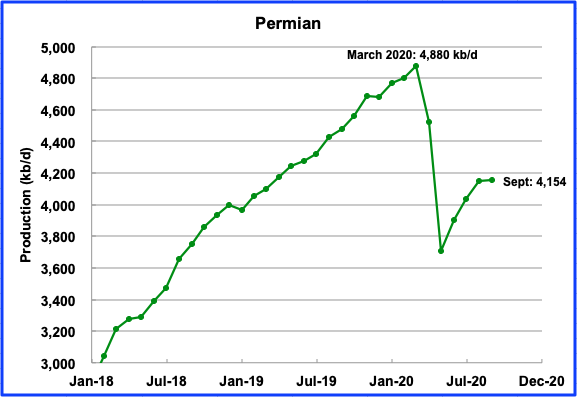
Permian output in September is projected to be 4,154 kb/d, essentially the same as August, up by 7 kb/d. July was revised down from 4,160 kb/d in the July report to the current 4,039 kb/d in the August report.
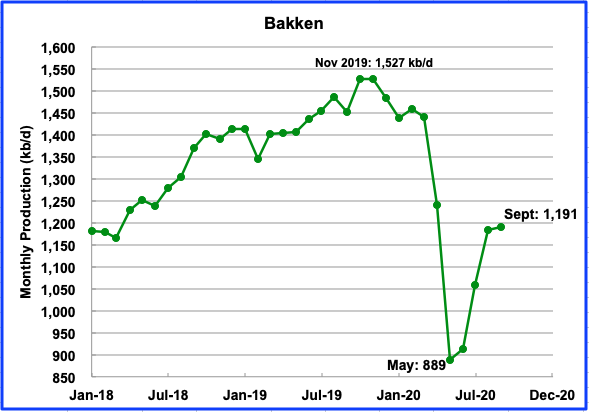
The Bakken had two big output drops in April and May and then is projected to begin increasing output from June to September to 1,191 kb/d.
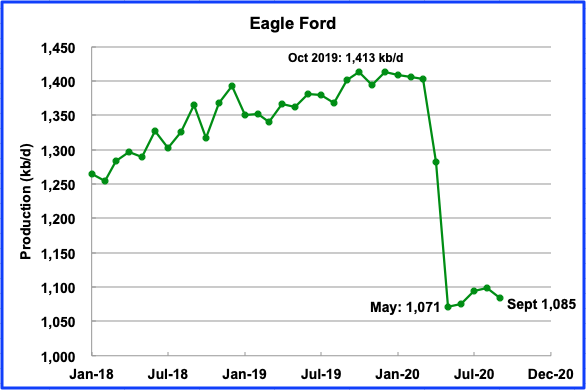
Eagle Ford’s output had its biggest drop in May, 211 kb/d to 1,071 kb/d. No significant increase in the Eagle Ford basin is expected between May and September. September’s drop is projected to be a much smaller 14 kb/d to 1,085 kb/d.
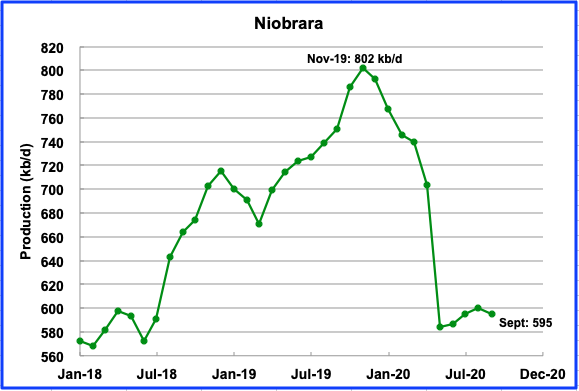
Niobrara output is expected to drop by 5 kb/d in September to 595 kb/d.
2) LIGHT TIGHT OIL (LTO) REPORT
The LTO database provides information on LTO production from seven tight oil basins and a few smaller ones. The August report updates the charts to July 2020.
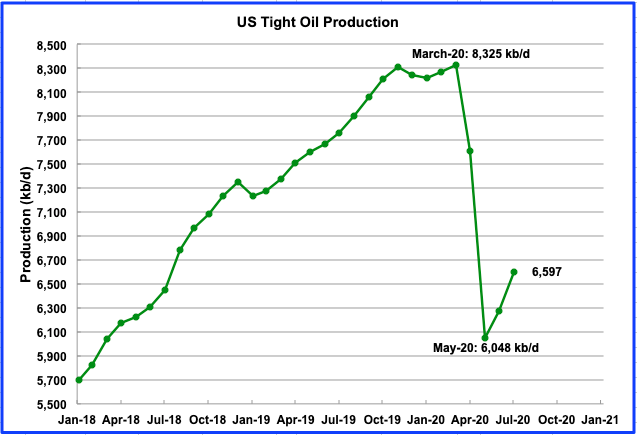
July’s total LTO output is expected to increase to 6,597 kb/d from a low of 6,048 kb/d in May. The drop from April to May was 1,564 kb/d.
Note that the August report brought significant revisions to the previous projections. For instance the July LTO report projected May output to be 6,970 kb/d compared to the latest estimate of 6,048 kb/d, a downward revision of more than 900 kb/d.
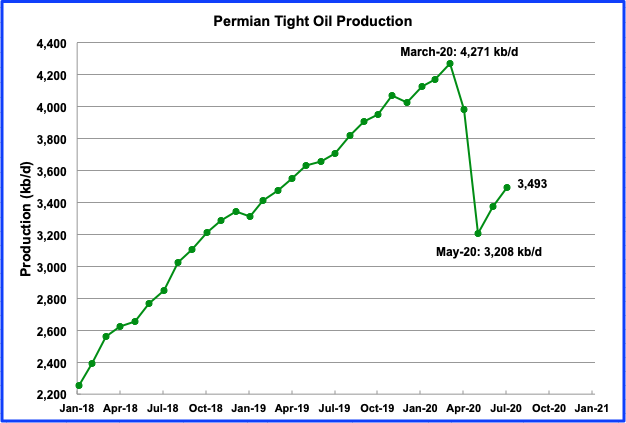
Permian output in July is projected to be 3,493 kb/d, an increase of 285 kb/d from the May low of 3,208 kb/d.
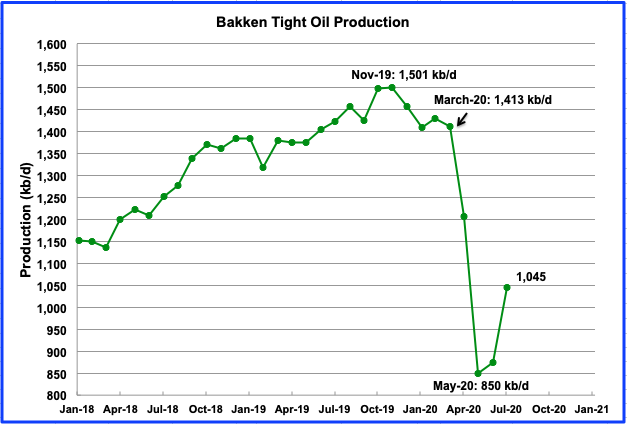
The Bakken is expected to add 195 kb/d to the May low of 850 kb/d by July.
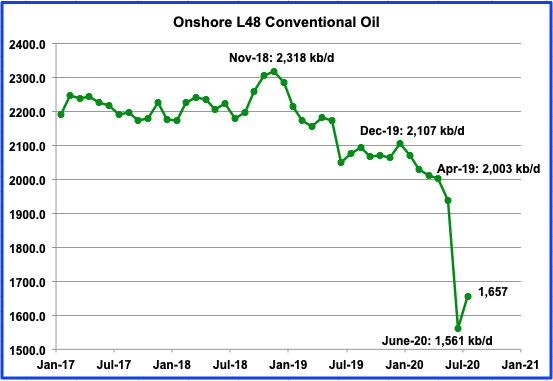
Conventional oil declined in the Onshore L48 by 442 kb/d from April to June. July is expected to restore 96 kb/d of conventional oil. Interestingly conventional oil in the L48 also peaked in November 2018, the current peak oil date.
3) SHORT TERM ENERGY OUTLOOK (STEO)
The STEO provides projections for the next 13–24 months for US C + C and NGPLs production. The August 2020 report presents EIA’s oil output projections out to December 2021
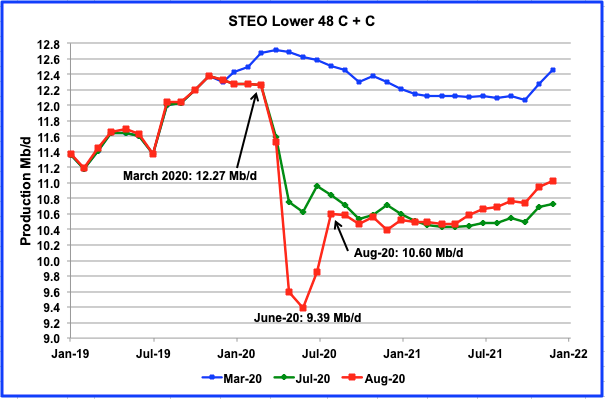
The August STEO report revised its July report estimates/projections down from May to early 2021. The production estimates for May, June and July are less than 10,000 kb/d. This is surprising since many wells that were shut down could have been reopened as the price of oil recovered. The August PSM estimated May output to be 10,001 kb/d. There has been much speculation as to whether the next PSM will revise May output up or down. The STEO is projecting a major drop of 2.88 Mb/d in US L48 production from March 2020 to June 2020. (Note that the STEO projection shows June to be the low point for US production. The first chart in this post shows that May was the low.)
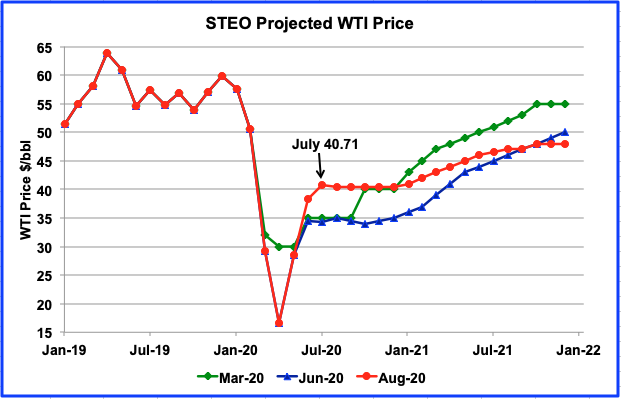
Now that the price of WTI has moved above $40/b in early August, it appears that the STEO March projection was closer to the early August price of $40/b than their June estimate. The August STEO is now projecting an average WTI price from July to December of $40.50, which is lower than the current price, close to $43.00 on September 1, 2020.
World Oil Production
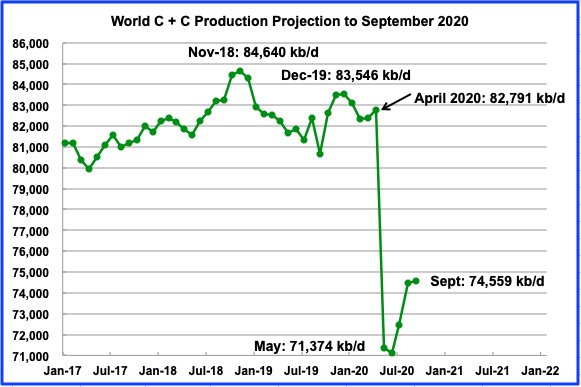
World oil production decreased in May by 11,417 kb/d to 71,374 kb/d. OPECʼs production decrease of 6,136 kb/d in May was added to Non-OPECʼs decline of 5,281 kb/d for a total decline of 11,417 kb/d. June is projected to be the low point in world oil output. Production is expected to recover to 74,559 kb/d by September. Note that the December 2019 high of 83,546 kb/d was 1,094 kb/d lower than the high of November 2018.
When will it end ?
https://www.reuters.com/article/us-global-oil-shale-investments/second-u-s-shale-booms-legacy-overpriced-deals-unwanted-assets-idUSKBN25R1GG
Sorry HH, I did not see your post until after I posted Jeffrey’s email with the same link.
I expected a little better rebound, and I’m really suprised that offshore production was down.
Now, I expect July production to be similar to June. Just WAG, as always…
An email from Jeffrey Brown. Comments below the link are his:
Second U.S. shale boom’s legacy: Overpriced deals, unwanted assets
In May 2019, Occidental bought Anadarko Petroleum for $38 billion, taking on debt to outbid oil major Chevron Corp (CVX.N) in a big bet on bigger growth in the largest U.S. oil patch in Permian Basin. The combined company was worth about $80 billion when the deal was announced, but is now worth just $12.1 billion.
Occidental cut expected capital expenditure for this year by more than half after oil prices plummeted and dropped its quarterly dividend to a penny per share.
“You took a company (Occidental) that was healthy, and potentially an acquisition target itself, and it looks like you created a much larger unhealthy company,” said one energy M&A lawyer.
Occidental stock is down about 90% from its peak in 2011, with a market cap of less of than $12B.
Maybe Chevron will step back into the game and buy them (Occid/Anadarko) soon.
Dennis ,on the last thread you posted ”World Bank suggests World real GDP falls by 5.2% in 2020 and then rises by 4.2% in 2021, growth would only need to be 1.3% in 2022 to get us back to the 2019 level of World real GDP. This is their reference scenario, they also have more pessimistic and optimistic scenarios ” .
Well the GDP data landed on my desk for growth of some major economies in the second quarter .
1 . India -23.9%
2. UK -20.95%
3. France -13.8%
4. Italy -12.4%
5.Canada -12.0%
6.Belgium -12.0 %
7 .Germany -10.1%
8. USA -9.5%
9. Japan -7.6%
10. China 3.2 % (believe this at your own risk )
I don’t see any chance of a recovery . I have earlier posted the situation in SE Asia . maybe you should reassess the situation . Read this
https://www.thetimes.co.uk/article/germany-extends-its-furlough-scheme-until-end-of-2021-nq9m58jb8
Obviously Germany sees no recovery till 2022 . In the Netherlands the scheme is now extended to July 2021 .
Hole in head,
Just reporting what the World bank’s middle estimate was in June. I agree it may be wrong. Likely any guess of future events will be incorrect, yours, mine, and anyone’s.
IMF June outlook at link below
https://www.imf.org/en/Publications/WEO/Issues/2020/06/24/WEOUpdateJune2020
An excerpt:
Global growth is projected at –4.9 percent in 2020, 1.9 percentage points below the April 2020 World Economic Outlook (WEO) forecast. The COVID-19 pandemic has had a more negative impact on activity in the first half of 2020 than anticipated, and the recovery is projected to be more gradual than previously forecast. In 2021 global growth is projected at 5.4 percent.
World Bank real GDP data for 1960-2019 at link below
https://data.worldbank.org/indicator/NY.GDP.MKTP.KD
Chart for 1980-2019 with exponential trend line for those 40 years in chart below, average annual growth rate 2.92% per year. Future rate is not known. The vertical scale is trillions of 2010 US$ (title of chart is mislabelled, I forgot the trillions.)
Note that World real GDP growth shifted from an average annual rate of 4.7% per year from 1960 to 1979 to 2.92% per year from 1980 to 2019. If we assume a similar shift occurs from 2020 to 2059, the we might see only average annual growth in real GDP of 1.2% per year over the next 40 years. One problem with such an assumption is that it does not take account of changing population growth, the analysis would be better in terms of World real GDP per capita (though still imperfect as it does not account for general well being or income distribution).
Just in . Australia down by -7 % . The ASX is up 1.6% on the news . First recession in 30 years . Theater of the absurd .
For World Bank data for World real GDP per capita from 1960 to 2019 we have the following average annual growth rates over 20 year periods.
1960-1979, 2.73%
1980-1999, 1.28%
2000-2019, 1.60%
future long term growth rate perhaps 1 to 1.25%, but essentially not known.
Dennis , I have already posted that if you were to follow WB and IMF then Greece should be running the marathon and Italy be running against Usain Bolt . Reminds of a Richard Pryor movie ,the dialog was when Richard was caught in bed with another woman in bed . Here goes :
Wife : I can’t believe what I am seeing .
Richard : Whom are you going to believe, your f ****** eyes or me ?
🙂
Your choice . 🙂
Hole in head,
Every forecast of the future proves incorrect, whether EIA, IEA, IMF, WB, you, or me.
The statistics are pretty obvious. The number of possible future scenarios is infinite and odds of presenting a correct scenario of the future are zero.
It really is that simple.
So complaining that old scenarios were incorrect is kind of like complaining that water is wet. 😉
The historical data is probably pretty accurate.
Sorry Dennis , you have not understood the concept of ” phase change ” in spite of my best efforts . All past experiences and narratives fail in the current environment .
Hole in head,
Your phase change is a nice theory without proof. There have been severe economic downturns in the past, always followed by recovery eventually.
If we make all of the wrong moves of 1929 to 1932, perhaps we will see a World depression as severe as witnessed in 1929 to 1938. I just don’t think humans are quite that stupid, but I could be wrong. As I have suggested before, the odds are long against your phase change scenario over the 2020 to 2029 period.
It is not that I do not understand, I am simply not convinced that your scenario for the future is correct.
We will see as the future unfolds.
Dennis
Americans are literally drinking bleach these days. Don’t underestimate stupidity.
Doodles,
Do you actually know anyone who drinks bleach?
There are a few really stupid people out there, unfortunately some of them are in positions of power.
Dennis,
Thankfully I do not as I’m in Canada, not that we don’t have special folk here as well.
But a google search returns a disturbing amount of news headlines of this happening across several states.
Beware of annualized numbers. For instance, that India figure of-23% is annualized.
Annualized GDP Data Can Be Misleading
When it reports quarterly GDP, the BEA presents the data several different ways to aid in analysis. Among them, GDP is presented as:
A percentage rate of growth or contraction from one quarter to the next. This figure was -9.5% in the preliminary Q2 GDP report.
A percentage rate of growth or contraction in the quarter on an annualized basis. This was the -32.9% figure in the preliminary Q2 GDP report.
That latter, annualized rate projects how much the economy would grow or shrink if the rate of change seen in the quarter continued at the same pace for four consecutive quarters, with some adjustments for seasonality and compounding effects.
There are reasons to look at GDP on an annualized basis. When the economy is operating more normally than it is now, annualizing helps you compare the quarter-to-quarter rate of growth for two different periods and understand in which the economy was expanding at a greater annual rate.
The trouble with this annualized GDP reading is that big outliers can create very distorted annualized readings. As the New York Times put it, if you got a $500 bonus one month, you wouldn’t think of it as a “$6,000 raise, on an annualized basis.” One-time windfalls like bonuses or one-time economic disasters like Q2 of 2020 can’t really be translated into a long-term trend.
The Extraordinary Second Quarter of 2020
As you may have noticed, the second quarter of 2020 was extraordinary. It’s fair to say that economic performance and the resulting data were a complete anomaly, thanks to the near-total economic shutdown that lasted for much of the quarter in most of the country in response to COVID-19.
In order for the economy to actually contract in 2020 as a whole by an annualized rate of down 32.9%, GDP would need to contract in Q3 and Q4 at a quarter-over-quarter rate similar to Q2, down at least 9.5%.
While many states have begun shutting back down again in light of more recent surges in coronavirus cases, the overall U.S. economy seems largely to have arrested its considerable contraction.
A considerable portion of the GDP contraction in Q2 was due to the coronavirus-driven total economic shutdown, during which there was virtually no retail, travel or hospitality activity whatsoever, accompanied by skyrocketing unemployment.
But economic activity was already picking up at the end of Q2. Consumer spending, especially on homes and autos, increased in June. In addition, 4.8 million new jobs were added in the month, although this part of the recovery appears to be slowing.
https://www.forbes.com/sites/advisor/2020/07/31/how-bad-was-second-quarter-gdp-really/#6ec60b714430
Nick , India figure is not annualized . It is quarterly . I report from ground zero and if you are interested can give you a detailed analysis industry-wise .
That’s correct. This is not annualized – India doesn’t report such data. Annualized data is confusing and I wonder why USA continues to do that. India is down 24% compared to same quarter (AMJ) last year. This was with 16% growth in government spending.
Jul-Sep would also be bad. GST collections for Jul and Aug are down about 14% and 12% compared to respective months last year. This compares to fall of 72% (yes negative 72%), 38% and 9% for months Apr, May & Jun respectively. June did see a bit of recovery, but things continue to be bad even as governments have opened up a lot more. Note that inflation is up nearly 6% compared to 3-4% recent quarters. So, real GDP growth would be lower than what you can infer from tax related stats.
Don’t expect any more fiscal or monetary stimulus (on account of higher inflation) to improve growth in short term. Any growth needs to be from private sector. However, there is so much fear and so don’t expect India to turn around soon even if governments open up completely. While stock markets are up close to pre-covid levels, it does not reflect activities on the main street. Western economies seem better poised for growth compared to India.
Diesel sales in Aug dropped 22% compared to Aug-2019. It dropped 13% compared to Jul-2020. Not sure why. Petrol (gasoline) fared better at -8% compared to Aug-19. Note that Petroleum products are more expensive now than it was in March because of higher taxes (this is not part of GST).
My guess . India will be the next Lebanzuela . Timeline starts Apr 2021 up .
It looks like a lot of people are confused by this. Here’s an article in India Today which reports that the US (at -9.5% on a quarterly basis) did worse than India (the bar chart shows the comparison).
https://www.indiatoday.in/business/story/gdp-contracts-by-23-9-india-second-worst-performer-after-us-among-major-global-economies-1717173-2020-08-31
So, India was hit harder than any other economy. Other articles report that the Indian lockdown was more aggressive than other countries, and argue that there will be a payoff in the form of a faster recovery. Does that seem reasonable?
Nick, the current govt messed up big time by doing a lot of dumb stuff . Three actions that cooked the goose .
1. Demonetization of the total currency except for small denomination in 2017 . They demonetized the old currency without printing any new notes . More dumb the new notes they printed were different in size to the old notes and could not be dispensed by the ATM machines . So then they had to refit all the ATM’s . This really was knockout blow .
2. A new tax system like VAT to consolidate taxes . Badly planned and even worse badly executed . Instead of 2 rates viz one rate for essentials like food ,medicines etc and one rate for all others they came out with 6-7 slabs . No proper definitions . Worst everything was planned to be digital in a country where there is sporodiac electricity , poor coverage of internet and most important more than 50% of the population is illiterate . Botched up.30% of the small business closed down as they were unable to complete or follow the rules and regulations . When Covid hit there was already a slowdown .
3. Came Covid and the government delayed action . When it did, it gave only 4 hrs rpt 4 hrs time for people to stock up on food . The lock down was announced at 8 PM ,imagine the panic . The lock-down was brutal . The police and local authorities were given unlimited powers to put people in jail . Everything came to full stop . After a month and a half they realised that they had failed in controlling the virus and that the treasury was empty . They then proceeded to do the unlock down . That was also done in a haphazard manner without any planning and botched execution . The three blows knocked the bottom out of the economic system and the country landed in a hole so deep . Wait for the coming quarter results in Oct ,this figure will be about 35 % as per the economists . All is frozen . All is dead . Terrible .
Down 35%? I don’t expect that. I am no economist and we still have Sep to go. But my wag would be negative 12-18%. And results would be published only by end of Nov.
This should be of interest to you .
https://www.youtube.com/watch?v=CQHshrl4iiw
Satish, another one that will be of interest to you . The Professor says it is not 24% but 34/35 % . Enjoy .
https://www.youtube.com/watch?v=yuKmhErXNNk
Well yes, even the official data for Q1 (AMJ) goes with those caveats that unorganized sector data was projected based on organized sector and that it was likely worse. But he doesn’t talk about -35% for current quarter. He mentioned -10%.
I agree economy is terrible in India and I have moved large part of my savings out of India and into precious metals mining companies around the world.
Satish, the last para . Do not ever,ever disclose this . the b****** at ED and DRI will make life miserable for you under FEMA(before was FERA) . I have first hand experience with the SOB’s .
I am aware of these regulations and am well within these. As someone who speaks for liberty and against government, I will add that I am shit scared of them and will not mess with these guys.
You are allowed foreign remittances upto $250,000 per annum including for purposes including foreign equity stakes. Disclosures during tax filing though have become very complicated since last year. You can make a career out of it with even tax auditors clueless on how to report these.
Happy for you . I don’t know the current regulations as I come from the era of FERA ,and of a period when even to send $ 100 overseas for a component meant getting RBI permission . Best of luck with your investments .
For Belgium, we have a drop of 12.1% at 2020Q2 compared to 2020Q1 when taking into account cyclic factors.
2020Q2 vs 2019Q2 is a drop of 14.4%.
Unemployement has only slightly increased currently, but a lot of companies are entering in very difficult times. Bankruptcies will increase in the coming month.
Current scenario is a GDP drop of 10.6% YoY in 2020, a recovery of 8.2% in 2021 and growth of 2-3% in 2022 to full recovery.
The German data indicate that the 2020 recession is as deep as the 2009 one.
The extension of Kurzarbeit scheme is convinient, as it is quite flexible. The important number is people in the scheme, this number is actually decreasing.
It is indeed expected that German will reach the same level of economic activity as December 2019 at the beginning of 2022, that would be the same picture as in 2011. What is your issue?
And one could add that the German labour market is now in a better shape than 2009
No issue at all , only a difference of opinion . You have verified exactly what I posted earlier and the link thereof that the authorities do not see any recovery till begin 2022 so they extended the furlough scheme to Dec 2021 . So where is the difference of opinion ? Dennis and you say we will be pre covid by sometime 1 Q 2022 . I am saying there is going to be no recovery, only a L shaped depression with several rebounds along the way . Forget ever reaching pre covid . Now coming to Germany, I am an ex auto man who has worked with OEM and keep in touch with what is happening . Well might be of interest to you that Continental workforce 100000 just fired 30000 and the boss said that another 10000 jobs will go . He sees no recovery till 2026 . See link . Regret it is behind a pay wall and only you can see the headline . I can send you such info on all the big OEM suppliers like Bosch,ZF, Valeo ,Luk, F&S,BWP,FAG,INA etc and of course on VW,MB also . No recovery in the auto industry means no recovery of the German economy . Just when things could not get bad Merkel is picking up a fight with its biggest market China over Hong Kong and Uighur Muslims . The public is underestimating the lethal blow Covid has dealt to the financial,economic,political and social system and is going to be terribly disappointed when things start falling apart . I only make an effort to make people aware of the gravity of the situation and in no way desire to scare them . To prepare you must be aware . Be well . link below
https://www.ft.com/content/db5b7869-8b0a-403e-b52a-f792df1bd736
Hole in head,
I am making an annual real GDP prediction for 2022, not a quarterly prediction. I expect annual output in constant 2010 US$ at market exchange rates will be greater than or equal to the 2019 level in 2022. No idea what the level will be for any particular quarter in 2022.
Highly likely I could be wrong, it might be 2023 or even 2024 before real GDP returns to 2019 level. I also agree IMF and World Bank are likely to optimistic in their best guess cases from June. These will be revised in September, and December, and … as they adjust based on new information.
Highly unlikely, less than 5% probability, that World real GDP will not return to 2019 level by 2025(full year).
Dennis ,thanks for your response . Like you said only time will tell . Let us wait it out . Can you do me a scenario where WTI remains in the range $ 45- 50 till end 2022 ? What will be the situation of Shale by then ? Of course this request goes to all specially to Shallow and Mike Shellman who cover themselves with the black goo so that a bum can live comfortably .
The tight oil scenario I use has oil price at 43, 45, 47, and 49 in June 2020, 2021,2022, and 2023. Tight oil falls to about 5 Mb/d in early 2022, and remains less than 6 Mb/d through June 2023.
See comments from earlier petroleum threads.
Chart of scenario for tight oil. Price starts at 45/bo for Brent in 2019 US$ in July 2020 and rises to $50/bo in Jan 2023, with prices assumed to rise linearly at a rate of $2/bo per year.
Dennis, just read the latest from Art Berman . He says ” “U.S. production may be 50% lower by mid-2021 than at year-end 2019. ” . I am more inclined to agree with him . I think you are underestimating the damage that the low oil prices will do to shale production .
hole in head,
We will see. My scenario assumes tight oil well completion rate remains at the June 2020 level (265 wells per month) until June 2021 and then will gradually increase to 530 wells per month over the next 20 months.
The forecast is consistent with that of Enno Peters from Shale profile up to June 2021.
Unlikely that oil prices remain low forever, my oil price scenario is quite conservative see
http://peakoilbarrel.com/us-june-production-rebounds/#comment-707881
I disagree with Berman’s analysis.
hole in head,
Consider the following tight oil supply projection from Enno Peters at wwww.shaleprofile.com
https://shaleprofile.com/us-tight-oil-gas-projection/
Tight oil output falls to about 50% of the peak level in Dec 2023, if the well completion rate remains at the July 2020 level (260 well completions per month) through Dec 2025, the Dec 2025 level of tight oil output is about 3800 kb/d.
Biden: ‘I am not banning fracking’
(CNN)Democratic presidential nominee Joe Biden said Monday he would not ban fracking in the United States if he were elected president, refuting repeated false claims by President Donald Trump about his stance on the issue.
“I am not banning fracking. Let me say that again: I am not banning fracking. No matter how many times Donald Trump lies about me,” Biden said in a speech in Pittsburgh.
Didnt we find explicit quotes from him during debates announcing his intention to ban fracking? I remember posting the video of the debate showing his quote. Clearly not a lie.
His staff has counted some votes in northeast PA.
Watcher,
Biden misspoke during a debate. The next day the campaign clarified the position.
In a March Democratic primary debate, he said: “No more – no new fracking.” The statement came after his then-rival Bernie Sanders said he would end fracking in the United States to combat global warming.
Biden’s campaign then said he meant he would not allow new federal land-drilling leases.
Dennis
I didn’t realize he misspoke. The GOP will run clips of the misspoken words. That is one of the problems. You get the first big headline on the front page. The correction is on P17.
I also think I heard him say that all NG power plants will be gone by 2035 and will kill Keystone XL. Between those three statements I said to myself, there goes NM, ND, PA, CO, OK, etc. Maybe he gains Nebraska with KXL.
I only heard the no new fracking, which I agree was a mistake. Generally campaign promises are difficult to keep and politicians often change their position, Trump does this about every 5 minutes he stands for only himself.
I don’t think Trump remembers or cares what he said 5 minutes ago. Neither do his followers.
Your being kind
Trump is worse than Hitler!!
Awoke To Cancel Culture’s Collapse
See here.
Rinses, repeats and presses of the reset buttons… with each new generation…
“Congratulations, you’ve inherited a dystopia. Now kindly run it, please. Thank you… Takers?”
Given what we are supposed to know about this nation-state crony-capitalist plutarchy dystopia, who in their right mind would run for president?
For the intermediate term (including the next presidential term),
fracking in the USA will be determined solely by economic factors. Period.
(yes, that is three periods for emphasis)
Who ya going to call to frack ? “Schlumberger has become the biggest oil-service industry player yet to abandon frack work in North America, a sign that activity in the U.S. shale patch may never revisit previous highs.” Ugly. How many Ba billion writeoff? Massive bleed out like BHP sale of Fayetteville.
https://www.rigzone.com/news/wire/schlumberger_sale_marks_shale_turning_point-01-sep-2020-163173-article/
I believe Halliburton will be happy to take that business.
World’s Largest Oilfield Services Provider (Schlumberger) Sells U.S. Fracking Business
https://oilprice.com/Energy/Energy-General/Worlds-Largest-Oilfield-Services-Provider-Sells-US-Fracking-Business.html
As for GDP above, and presumed consumption alignment, the most disquieting truth about it is a lot of stimulus flowed in Q2.
Watcher,
Yes some stimulus flowed, typically in a catastrophic economic situation more is always needed.
Interesting .
https://indianexpress.com/article/business/world-market/one-of-the-worlds-richest-petrostates-is-running-out-of-cash-6580063/
Russian oil production was up 479,000 barrels per day in August, from 9,382,000 bpd to 9,860,000 bpd. That is converting tons to barrels at 7.33 barrels per ton.
Reality Hits Shareholders Of Formerly Bankrupt Whiting Petroleum
“Whiting Petroleum Corp. (WLL) exited Ch.11 bankruptcy on September 1 and shareholders are getting 0.0133557960 of “new” WLL shares ” Thank god for Energy Dominance
https://seekingalpha.com/article/4372075-reality-hits-shareholders-of-formerly-bankrupt-whiting-petroleum
This is much worse than the 1 for 4 share reverse split Whiting had done pre BK.
It’s not like that at all. The charts are misleading. What’s referred to as energy ‘consumption’ in the charts is an unavoidable mistake in labeling. It unfortunately treats all the fuel consumed in all sectors of the economy equally. But that is really wrong.
The fuel used to produce fuel is not only an ‘expense account’ item, but is also on the expense side of the energy ledger, and thus doesn’t contribute to the greater social need for liquid fuel. This simple notion is exemplified by the Permian/Bakken shale bust, and explains why the world came out of the so-called shale revolution $200 Trillion in unpayable debt.
peter,
If oil prices remain at $55/bo or less for Brent in 2019$, then Permian debt will not be repaid.
A scenario with oil prices rising by about $2/bo annually until reaching $ 70/bo and then remaining at that level for 10 years and then declining at the same annual rate to $30/bo allows all debt to be paid by 2032 and the cumulaive net profits of about 400 billion out to 2060. Total economically recoverable resources about 45 billion barrels for Permian in such a scenario.
Correction, I remembered Permian URR incorrectly, it is about 51 Gb of economically recoverable resources (ERR) for oil price scenario in chart below, for all US tight oil the ERR for this oil price scenario is about 78 Gb.
Some Latino site has translated this months post into Spanish.
https://www.diariodelatinos.com/?p=42395
Ha, bueno… Fernando?
Hey, I like the new mathematical names by the way: Dennis+Coyne, Nick+G, shallow+sand… All very+cute.
Yours,
~ Cae+MacIntyre ^u^
https://www.manufacturing.net/energy/news/21172618/qa-more-oil-and-gas-bankruptcies-coming
https://peakoil.com/consumption/peak-oil-production-seen-by-2040-as-iea-calls-2020-turning-point-for-energy
Total CEO expects oil supply to peak between 2030 and 2040. By 2050 supply might be around 40 mb/d. That suggests a steep decline rate after the peak.
Toby,
An oil shock model which assumes a URR for C+C of 3000 Gb and a peak in 2030 at 84 Mb/d (C plus C) has World C plus C output at 57 Mb/d in 2050, reaches 40 Mb/d in 2063. I assume in this scenario there is a slow transition to alternatives to oil as supply declines and also that oil prices remain low (under $70/bo in 2019 US$). A faster decline in demand might lead to lower output than this scenario, but it would be demand driven, not due to lack of supply.
The Real Reason The Oil Rally Has Fizzled Out
Focusing mainly on the decline rate of shale and the lack of new drilling, I’ve made the point repeatedly in OilPrice articles that the shale miracle in the U.S. is over. Here is a link to my most recent writing on this topic. Shale was thought to be impervious to decline by many. Some of us (speaking of myself here) always knew better as we understood the short-decline nature of the rock. Now companies are taking write-offs on shale as they did deepwater assets a few years ago, meaning there are reserves we thought would be available in the years ahead that will now be uneconomic.
Seems US oil production fall below 10 Mbpd, is it related to bad weather?
https://www.eia.gov/dnav/pet/hist/LeafHandler.ashx?n=PET&s=WCRFPUS2&f=W
Freddy
I think this drop is related tp the Hurricanes from last week when GOM wells were shut down.
Bloomberg Radio blurb. US domestic air traffic July -70 percent compared to July 2019. China domestic air traffic in July -30% compared to July 2019.
Latest from Art
https://www.artberman.com/2020/09/03/stop-expecting-oil-and-the-economy-to-recover/
Thanks,Longtimber . Good find .
Art is basing his ideas on Nate Hagens. Nate, in turn, is 50 years out of date. Nate assumes that fossil fuels are essential, and that they can’t ever be replaced by, say, wind and solar. He calls solar “fixed”. I suppose that’s true, but it’s fixed at 100,000 trillion watts! He quantifies current human energy consumption at 17 trillion watts…
and provides this source:
https://www.sciencedirect.com/science/article/pii/S0921800919310067?via=ihub#bib0385
which claims that renewables cannot replace FF for high temperature industrial applications:
“4.5. Energy substitutability
Modern economic theory considers all inputs fungible and substitutable. If the price of one input gets too high, the market will develop an alternative. However, energy does not cooperate with this theory because different sources of energy exhibit critical differences in quality, density, storability, surplus, transportability, environmental impact, and other factors. For instance, there are hundreds of medium and high heat industrial processes (for textiles, chemicals, cement, steel etc.) using fossil fuels that have no current (or even under development) alternative using low- carbon technology (Khanna et al., 2017). Energy can only be substituted by a similar form/quality energy.”
based on the following source: https://escholarship.org/content/qt1ph8w8m2/qt1ph8w8m2.pdf
The citation does not support that claim. It instead assumes that renewable electricity can support industrial processing of glass, etc. Three specific applications are considered, including:
Replacing fossil fuel melting with electricity in the Glass sector
Replacing coal firing with electricity in the Food and Beverage sector
Replacing heat dryers with electricity in the Pulp and Paper sector
Nate is Right and Wrong. If we remove head from ass PV is magic . If you buy stuff that is not Grid Dependent L O C A L PV with Storage works better than anything. If you continue to reject the majority of watthours, not a chance – UR Toast. Energy Transition has to be done in Phases. No Light Out – Oh wait, energy required for solid state light is minuscule.
Art is basing his ideas on Nate Hagens.
I did not get that from the article. It reads like he simply agrees with Nate on many points. From the article:
I expect that the mix of energy sources will be similar initially. That will probably change as declines to meet the decreased carrying capacity of a society deprived of fossil energy productivity. Then, I imagine the world will move increasingly toward lower productivity energy sources like wind and solar. A viable economy may very well be created based heavily on wind and solar. It will, however, support a much poorer world than we have known for many decades in the world’s advanced economies.
I think that is being extremely optimistic. To expect a world economy supported by renewable energy to be as rich as an economy supported by fossil fuel is just totally unrealistic. Does anyone in their right mind believe air and sea travel and shipping relying totally on renewable energy to remotely resemble air and sea travel and shipping powered by fossil fuel?
Sure. Electricity from wind and solar is cheaper overall, than from fossil fuel. When wind & solar are overbuilt to anything like the 2.5x ratio of the current grid, the grid will produce (or be able to produce) 2.5x as much power as the current grid: the majority of the time wholesale electricity will be priced at almost zero.
So, electric transportation will be as cheap or cheaper then ICE transportation: this will cover the large majority of ground shipping: rail and most trucking.
Aviation is likely to use synthetic fuel. Synthetic fuel is technically doable now, its just very uncompetitive due to the high price of power, which is the majority of the cost of production. If there’s a great deal of very cheap electricity available then synthetic fuel will be roughly competitive with oil.
Water shipping might use hydrogen, as might long-haul trucking: it will be an interesting competition between synthetic hydrocarbon liquid fuel vs hydrogen.
When wind & solar are overbuilt to anything like the 2.5x ratio of the current grid, the grid will produce (or be able to produce) 2.5x as much power as the current grid: the majority of the time wholesale electricity will be priced at almost zero.
Oh good God, do you really believe that? Nick, you are simply delusional.
Aviation is likely to use synthetic fuel. Synthetic fuel is technically doable now, its just very uncompetitive due to the high price of power, which is the majority of the cost of production.
From thin air? No, that is not possible. Yes, you can produce nitrous oxide from thin air, but not jet fuel. The air contains no fuel.
The US Air Force Synthetic Fuels Program
Late in 2007 the US Air Force released the final test report covering flight trials of a synthetic aviation kerosene, flown over a year using a service B-52H bomber. This is first step in a carefully planned long term effort which is intended to wean the US military machine off imported petroleum products, the aim being eventual replacement of crude oil based fuels with products made from natural gas and coal, where possible sourced within the US.
Nick, synthetic aviation fuel is made from coal and natural gas, both fossil fuels!
I will not even comment on hydrogen. Hydrogen is a joke.
Ron,
First step, to understand renewable overbuilding: look up the overall installed generation capacity of the US. EIA has the data, take a look.
Next, do just a little research (just a quick google search) on synthetic liquid fuels. You’l find that there’s a great deal beyond the Air Force’s program of Gas to Liquid (GTL) and Coal to Liquid (CTL).
Here’s some articles I happen to have already:
Decentralized fuel synthesis from CO2 & water from air. “The process to convert them to a liquid fuel is well understood”, but a centralized large-scale facility might be better:
https://www.scientificamerican.com/article/could-air-conditioning-fix-climate-change/
Navy pilot plan for jet fuel from seawater, in 2014. Costs of $3-$6, 10 year development.
https://www.smithsonianmag.com/innovation/fuel-seawater-whats-catch-180953623/
followup on Navy plan, with inexpensive catalyst.
https://www.sciencedaily.com/releases/2020/07/200715123120.htm
H2 from seawater: new electrodes to put on par with freshwater
https://news.stanford.edu/2019/03/18/new-way-generate-hydrogen-fuel-seawater/
Remember: fossil fuels are pretty much just hydrocarbons: combinations of hydrogen and carbon. You can get hydrogen easily enough from water (seawater is cheap) and you can pick up the carbon from the air, or water (it has a higher concentration than air). The key ingredient, the difficult ingredient, the expensive ingredient is electricity. And that will be getting cheaper and cheaper. And even if it doesn’t it will stay affordable: combined with greater efficiency aviation and long distance shipping would be perfectly viable.
“Nick, synthetic aviation fuel is made from coal and natural gas, both fossil fuels!”
Please, try to understand the basics befor posting. You can of course make syn-fuel from H2 and CO2.
The price per kWh thermal energy is around 10-20 cents at the moment, that would be 160 – 320 USD per barrel.
The major contributions to the cost are electrolysis and costs of chemical reactor for the methanisation step, electricicty is secondary, that will however change with cheaper electrolysis and reaction.
The cheapest syn-methane is at the moment made by a combination of bioreactor and electrolysis, the biogas consists of 50% CO2 which is in the presence of H2 converted into methane by the bioorganisms.
The price per kWh thermal energy is around 10-20 cents at the moment, that would be 160 – 320 USD per barrel.
Well, this is for finished fuel, right? So you wouldn’t want to compare it’s cost to that of crude oil. You’d compare a cost of about $1.50 per liter to the per liter cost of conventional fuel (which is comparable in Europe).
The major contributions to the cost are electrolysis and costs of chemical reactor for the methanisation step, electricicty is secondary, that will however change with cheaper electrolysis and reaction.
Could you break out the costs?
Thank you Ron for the book recommendation – Alchemy of Air. I am in the middle of it and it has refocused my attention on what really matters. Humans have lived without FF energy (not many of us and not an easy life) but fixed nitrogen in the soil is the limiting factor. A must read.
Karen
I too am in the middle of reading this book. Great history. I was in Paris in 2005/2006 when I had my big awaking about oil after reading TEOTWAWKI. I remember being moved to tears (me and mine were drinking wine, eating cheese and bread on the lawn with the Eiffel Tower as a backdrop) when it came over me like a wave – watching all the people going about their busy lives, knowing that many didn’t have a clue as to what was going on in the world of energy. Life as the tip of the ice berg, unaware of what it took below to have the tip.
The Alchemy of Air is another eye-opener. If a majority of humans alive today understood what it takes to put food on the table, they would be shocked and scared. But they are not, thanks to all the distractions of the consumption age driven by technology. Thank sky daddy for all these marvelous contraptions that keep our heads down… every day I wonder, is this the day? Is this the day the other shoe drops? Something is holding it together, by a thread.
Could it be as a clothing ad I saw this morning online so aptly put it “Liquor (noun) – the glue holding this 2020 shitshow together.” Ah, well. Back to the book – thanks again Ron!
The role of atmospheric nitrogen conversion to usable forms [nitrite, nitrate,ammonia] in providing the protein supply of humanities 7.8 Billion cannot be understated.
If not for the manufacture of nitrogen fertilizers, population would be well less 2 billion, and maybe less than 1 billion. Within a decade- (how big is your spam warehouse?).
How much energy does the world consume to provide the nitrogen fertilizers?
“Worldwide, the Haber-Bosch process consumes 3 to 5 percent of all natural gas produced, around 1 or 2 percent of the world’s entire energy supply,”
I assert that this energy use will one of the last to go, in a world that is overpopulated and becomes short of energy. In this scenario, class 1 and 2 farmland becomes invaluable. We should already be treating it as such, rather than paving any of it.
There are a few technological advances that are of interest in the arena.
1. People are working to improve on the H-B process, and have been for a hundred years. No big breakthrough yet, but I wouldn’t discount the possibility out of hand. Here is an example of the work people are doing – https://phys.org/news/2019-04-ammonia-production.html
2. 2029-Imagine the wind is blowing strong 100m above the Iowa landscape on night, and the grid demand is low at this time night. All of the farm machinery batteries are charged up full. The electricity can be used for ammonia production.
Read up on the possibilities if you are interested-
https://www.sciencemag.org/news/2018/07/ammonia-renewable-fuel-made-sun-air-and-water-could-power-globe-without-carbon
https://www.ammoniaenergy.org/topics/green-ammonia-synthesis/
Yes, there really is an Ammonia Energy Association. Should be of no surprise considering how important the whole sector is to the life of humanity.
If not for the Haber /Bosch process, most of us would not be here right now.
And the planet would be in better shape.
Natural gas (aka methane aka CH4) is used because it provides hydrogen, which is combined with atmospheric nitrogen in the Haber-Bosch process.
There are other sources of hydrogen – the most straightforward is electrolysis of water, using seawater and renewable electricity. NG is not necessary to produce fertilizer.
—
If H2 got more expensive, how much would it increase the retail price of fertilizer, and how much would that increase retail food prices?
The fact that H2 from electrolysis isn’t price competitive is very, very different from it not being viable. Beta VCRs couldn’t quite compete with VHS, but if VHS had never existed, Beta would have worked just fine. There are an infinite number of other examples of things that were viable, but couldn’t quite compete.
If the H2 input is 30% of the retail price of fertilizer, and fertilizer is 10% of the price of food, then a doubling of cost for H2 would only increase food prices by about 3%.
And, how much would farmers shift their crops towards less intensive fertilizer crops, and more careful fertilizer utilization?
The point is: a substitute for NG for fertilizer does indeed exist. If we transition away from NG (or it depletes) it won’t be the end of the world. No one would starve.
—
That’s a worst case scenario, which assumes current pricing of electricity (and current electrolysis engineering). Large scale installation of wind and solar are likely to be over-built, to reduce the impact of intermittency. That will produce massive amounts of surplus power, which will be dirt cheap for this kind of off-peak, secondary consumption.
—
And, if it doesn’t, then that would mean that wind and solar intermittency was solved by less expensive tactics than over-building, which is only to the good, for the overall energy system.
On an overall system basis, it works either way.
Nick. “The point is: a substitute for NG for fertilizer does indeed exist. If we transition away from NG (or it depletes) it won’t be the end of the world. No one would starve.”
True perhaps, if we had 200 years to adapt (massive downsizing of population).
Otherwise, nice dream.
I’m not a buyer.
btw- I have high level Univ degree in food production and related sciences, so my view is a little beyond speculation on this.
btw- I have high level Univ degree in food production and related sciences, so my view is a little beyond speculation on this.
I don’t have any of that shit but I agree with you anyway. (-;
Hickory,
That’s fine- please give some specific argument, ideally something with numbers, showing why a transition would be so difficult.
Real Food Security
I’m tempted to agree by the simple fact that I can identify and eat, which I do, lots of so-called weeds in my immediate area.
Apparently, too, wild edibles are far more diverse and nutritious than the crap that passes for food at the grocery stores. Not only that, but they’re free, save for the effort required to gather them, and often very hardy, which might be a godsend, given climate and other ecosystemic change considerations.
Also, there are vast tracts of green space– often in the form of idiotic lawns that must be regularly mowed by fossil-fuel-powered machines– in and around towns and cities that are or can be used for urban gardens, no matter what’s grown. And when you bring the community in on gathering and gardening, including the kids, other positive effects can happen, like extra concern for the health of the locale, including its soils; extra general related knowledge, such as about other plants and their alternative usages, like for medicine; and self/local/community-empowerment, compared to the relative self-uselessness in some regards and worse inherent in letting some distant crony-capitalistic profit-driven chemical psychopathic corporations feed us.
“Down the hatch you little fuckers.” doesn’t seem too far removed from the attitude embedded in our plastic-wrapped corporate-industrial muffins, steaks and baby food.
That said, I wonder if some forms of education– formal or otherwise– can actually lead one further astray from reality or what works best.
My idea of ‘food production’ seems quite removed from genetic engineering, industrial processes and dumping a whole lot of toxins on already dead soil, but what do I know?
BTW, Dennis, you’ve sometimes asked me how we get to ‘Plan B’ or somesuch question. Well, there’s some more of my answer. If you live near the sticks near Boston, you should have a veritable buffet every summer right under your nose.
But gather wisely. Coax/Nurture/Plant the plants and let/help them grow. Be a kind of 'Johnny Appleseed' for everything. Don't mindlessly uproot/de-leaf/etc. everything and leave nothing behind. Think of the future and of other gatherers. Teach and do responsible gathering, always.‘Plan B’ is not really that hard to imagine and it’s beyond fantastic. It makes ‘Plan A’ look like the dystopia that it is.
But what is a healthy ecosystem but a kind of symbiotically well-managed resource by all its co-inhabitants? This appears key.
Nick, its a silly discussion. Like we don’t need the earth, because there are other planets that may be similar.
So, no thanks.
Yeah, I know. It’s like the discussion 120 years ago – everyone knew that oil powered horseless carriages couldn’t replace horses: there were way too many horses,and not nearly enough oil.
Oh, wait…
What will probably happen: New cereal crops will be bred that fix nitrogen themselves, making nitrogen fertilizers superfluous.
https://www.frontiersin.org/articles/10.3389/fmicb.2018.01794/full
Meanwhile “fake meat” will massively reduce demand for cereals.
There is also a good chance that the rise of EVs will significantly reduce the corn, rapeseed and sugarcane crops used to manufacture methanol.
I disagree entirely. Biomass per hectare is much higher in untouched natural systems than with human industrial agriculture: “The forest precedes man, the desert follows him .”
The soil is the plant gut. Industrial agriculture kills the plant microbiota. It is not sustainable. To avoid mass starvation we must turn to regenerative agriculture. No need for artificial fertilizers.
Flush toilets and sewage mains are perhaps the most environmentally destructive practice of man see
https://humanurehandbook.com/.
http://eautarcie.org/
http://carbonfarmingsolution.com/.
Schinzy, I don’t think you understand Hickory’s point at all. You are agreeing with him, not disagreeing. You quoted François René Chateaubriand: “The forest precedes man, the desert follows him .” And that desert produces nothing without ammonium nitrate.
Hickory was dead on with that statement.
The crop yields (things like gms protein/acre) in cropping systems under annual harvest without adding chemical fertilizer (or manures on a mass scale) are what we today would consider poor- instead of 160 bushels/acre of corn in the midwest, 20 or 30 bushel/acre would be reasonable if the land is managed very well.
Sure it is possible to do without nitrogen fertilizer, but the assumptions with that scenario would have to include a human population much closer to 2 billion than 8 billion, much less meat consumption/capita, and much more careful management of manure- including humans.
Sure we could get there. But it is fairyland to think that it is a short or easy path. How do you get to 2 billion people from 7.8 billion?
One way is to deplete the fossils at a rate that is faster than building up alternatives sources of energy production. That will reduce population the hard way (very hard). That is the path we are on.
btw- as slight aside, a profound plant science international effort is underway to re-engineer photosynthesis, and the early results are greater than surprising on the upside. From a science perspective, I’d put the whole effort in the shocking category.
I agree with Hickory in the sense that industrial agriculture used and uses huge amounts of artificial fertilizer produced from natural gas.
However, we did not have to do it this way. There are other means of feeding humanity. Hickory does not have a uniqueness theorom. The reason industrial agriculture sold was increased productivity, that is to say more food per hour of human labor. Regenerative agriculture can feed the world with less surface area and fewer energy inputs at the price of more labor inputs and a better understanding of ecology. The future is regenerative agriculture. The average age of the US and European farmer is over 55. Jean-Martin Fortier gets 300 applications a year from young people with diplomas willing to work for low wages at his farm because it’s exciting to learn to produce food with rather than against nature. Apricot Lane Farms has similar success.
Recommended viewing: How I fell in love with a fish and The Biggest Little Farm.
Remarks:
1) It is not easy. It takes time and creativity. It took Apricot Lane Farms 7 years to get going.
2) In order to succeed, we have to quit wasting the valuable resource that is our excrement. For hundreds of millions of years the microbiota in the soil has recycled animal excrement making it digestible for plants. That is how the system supported a far larger biomass than that produced by industrial agriculture for so many years.
3) I have not researched yields. One hears a lot of extraordinary claims about yields, but I don’t know of serious studies backing them up.
Schinzy,
How does labor productivity compare between the two systems?
Labor productivity…
1 barrel of oil = 8 years of human physical labor
Well, a barrel of oil, refined, can produce about 44 gallons of product (including “refinery gain”), which would cost at least $2.25 per gallon, or $100 per barrel of refined product. If we put those into an engine they might produce around 15 kWhs per gallon, for about 660 kWhs.
PV these days can produce power for less than 3 cents per kWh (1.3 cents in the very best places), so that power from solar would cost very roughly about $20.
Which gives us a clue as to whether oil can compete in the years ahead…
Permaculture & The Like
Our food, including our lives in general, need to return back to each human’s individual, visceral grasp as it were, or very close by, to have any hope of being saved.
We have become way too overextended, overspecialized and generally detached and fragmented and, as such, out of holistic touch with much of anything or anyone anymore.
‘Agriculture’, so to speak, needs to lose much of its meaning, especially vis-a-vis its inherent natural decontextualizations and, along with its human, enter into a new meaning and reality that seeks a renewed symbiotic and holistic relation with the rest of the living world. The sooner this happens, the easier and less painful it will be. If there has to be much difficulty or pain at all it is with remaining hooked on the current industrial agro drug.
It’s heartening to hear from Shinzy and other sources that an apparently increasing number of people, especially the younger ones, are kicking the habit with an interest in ‘getting back to the land’ where we belong.
More power to them/us.
It wasn’t like this in old times.
1 barrel of oil = a few weeks labour with the horse & cart or horse & plow
or
a week in the wood (if you only need the heat).
There was a lot of bio fuel usage in old times (horses, mules, donkeys, bulls). For long distance heavy transport it was wind energy.
For ferilizer:
Sewage sludge was used as fertilizer until a few years ago in Germany. That’s forbidden now, because of enviromental rules. They try to build facilities to reclaim at least the phosphor.
I’m a small organic dairy and we can’t use fossil derived fertilizers and are limited by the legume fixation rate and recycling of animal wastes for nitrogen. Its a more labor intensive system and not conducive to grain/commodity farming. Properly managed the average output might be brought up to 50% of current system but would take at least 5-10x number of farmers to do so.
I suspect the answers to food production going forward will be conventional ag adopting some of the soil regenerative practices of organic ag like cover cropping, intercropping and animal integration with more moderate uses of nitrogen and fossil fuel derived synthetics. I know wind to ammonia is feasible at high energy prices as well. Seems like all that is needed is high enough energy prices to drive it.
Mil…Farmer-
I completely agree.
“I suspect the answers to food production going forward will be conventional ag adopting some of the soil regenerative practices of organic ag like cover cropping, intercropping and animal integration with more moderate uses of nitrogen and fossil fuel derived synthetics. I know wind to ammonia is feasible at high energy prices as well. Seems like all that is needed is high enough energy prices to drive it.”
Indeed “The soil is the plant gut.”
https://symphonyofthesoil.com/
A must watch. we got to experience soil building in action @ Singing Frogs Farm attending The Peak Prosperity Conference.
Grow Your Own
“To turn the world into a dependency on staples has nothing to do with feeding the world, it has a lot to do with
controlling the food supply. The United States evolved a phrase during the Vietnam war, and the phrase was; ‘Food as a weapon’; the use of food as the ultimate weapon of control. And the tragedy is,the growth of agribusiness in the US has gone hand-in-hand with the US foreign policy to deliberately create hunger locally in order to make the world dependent on food supplies, through which you can then control countries and their decision-making ability. So hunger has become an instrument of war.” ~ Vandana Shiva“Control the oil and you control entire nations; control the food and you control the people.” ~ Henry Kissinger
Nick, self driving long haul trucking would even work based on batteries: The robotic vehicle would drive for about five hours, then recharge one hour. In 24 hours, it would be driving 20 hours, much longer and further than any human trucker, and this with a limited reach of about 350-400 miles per charge.
Super heavy trucks ruin roads
The Struggle to Mend America’s Rural Roads
As supersize vehicles bear heavier loads, maintenance budgets can’t keep up. Meet the Wisconsin farmers paying the price.
America road system is massively overbuilt and will never pay for itself. This is especially true in the rural Midwest. But rural folk vote Republican, so the waste will go on.
Lovely.
Yeah, that would work. And swappable batteries would work as well – with commercial fleets you have a limited number of service locations, so it’s much more feasible than personal passenger vehicles.
You might want to read my recent stuff on the non-petro side. A quote from it:
“‘In a world of renewable energy nothing is what it seems.’ ‘Environmentally friendly’ turns out to be devastating to the natural wold. ‘Cheap’ is expensive. ‘Local support’ is found at a distance. ‘Sustainable’ is strange to say, short lived and unaffordable. A ‘contract’ is not binding, ‘secure’ is actually unreliable. ‘Love’ is hate, ‘black’ is white, and ‘green’ is a murky shade of brown.“
The idea that air travel in its current form is essential to human civilization is very doubtful. For example, most flights in America are just compensation for miserable surface transportation.
Air travel is too fast — passenger planes have been slowing down steadily since the late sixties, to save fuel costs. so if there are fuel limitations, planes may simply slow down to compensate. Also hybrid planes with electric engines in addition to fossil fuel engines would save a vast amount of fuel. One big reason planes burn so much fuel is that they use the same engines to cruise as they do to take off, so they are wildly oversized for the job they do. Something similar applies to cars BTW, which is why mild hybrids switch off the ICE when they are on the highway.
To get serious about battery powered planes, batteries need to improve density by 50-100%, which will take years. But denying that technical progress is possible will make you look silly in a few years.
The idea that air travel in its current form is essential to human civilization is very doubtful.
I don’t think I have ever made such a claim.
But denying that technical progress is possible will make you look silly in a few years.
Works both ways. We were supposed to have flying automobiles by 1960. I could name dozens of other things that pie in the sky futurists have predicted that are also likely to never happen.
Nevertheless, I think battery-powered passenger and cargo planes are a pipe dream. Yes, there will be battery-powered planes. Hell, a human-powered plane crossed the English Channel. It didn’t carry any passengers, however. But do you think batteries will every replace bunker fuel to power ships on a months-long journey? Nuclear of course, but not batteries.
But you miss my point entirely. I believe the days of ever-advancing technology making our lives better are over. All those things have made it possible for our earth’s population to reach unsupportable levels. The future is not as rosy as it used to be.
Ron.
My young brother in law says something that seems to ring true. He’s a smart guy, even keeled to the point of being maybe too much so. Works hard, basically works and helps my sister in law take care of their young kids.
Here’s the gist of what he says: “I sat in high school and watched 911, rest of high school was Afghanistan and Iraq, graduated college as GFC hit so took a year to find a job, things started to seem normal, then Trump was elected, and now we have COVID. I really wonder if there will be a ‘good time’?”
From a distance he has also watched the volatility in the oil and grain space we have dealt with, plus a highly volatile stock market. National debt soaring.
Yep, have to say 1980’s and 1990’s weren’t too bad in relation.
Shallow Sand
My take is that I lived the golden years, 1975 to 1995. Retired from full time work in 97 as I felt things were starting to turn. Did private consulting for five years and then retired my pen.
Life’s Short
Golden Years
“Don’t let me hear you say
Life’s taking you nowhere, angel
(Come get up, my baby)
Look at that sky, life’s begun
Nights are warm and the days are young
(Come get up, my baby)…”
Ron
Airbus built a small Electric plane to fly across the channel. Not much chance to scale it up.
https://newatlas.com/first-electric-aircraft-cross-english-channel-airbus-cri-cri/38410/
Ron –
Ever advancing technology is making lots of people’s lives better. For example cell phones may seem like a pointless toy in countries with plenty of land lines, but they are a revolution in Africa. Phone based banking is also a revolution, allowing vast numbers of people who will never see a brick-and-mortar bank to save and invest.
Solar + LED are bringing light to the poorest, like here in Mauritania:
https://www.google.com/maps/@18.1052389,-15.9479861,3a,75y,248.9h,90.08t/data=!3m8!1e1!3m6!1sAF1QipPnQuENIidd6oPG9VhpcRArcreFsgLgEfagA_tT!2e10!3e11!6shttps:%2F%2Flh5.googleusercontent.com%2Fp%2FAF1QipPnQuENIidd6oPG9VhpcRArcreFsgLgEfagA_tT%3Dw203-h100-k-no-pi-4.0159774-ya305.04364-ro6.472701-fo100!7i3584!8i1792
Also short hop commercial passenger flights are coming very soon:
https://www.aerospaceservices.ca/2020/08/25/from-seaplanes-to-eplanes/
https://www.flightglobal.com/airframers/all-electric-grand-caravan-makes-maiden-flight/138600.article
Meanwhile, battery density continue to rise.
Wow never read anything like that from Mr Berman before. Basically he’s saying the collapse of civilization has begun.
References Nate Hagans The Great Simplification, read it because both of these dudes are way smarter than any of us.
https://citizenactionmonitor.wordpress.com/2019/06/10/the-great-simplification-coming-next-decade-with-30-drop-in-capitalist-economies-says-dr-nate-hagens/
References Nate Hagans The Great Simplification, read it because both of these dudes are way smarter than any of us.
Yeah, I agree. Well, that is concerning the subject under discussion here.
Today’s Oil rig count
US up 1 to 181
Permian flat at 124
Texas down one due to Texas Permian down 1. NM Permian is up 1. Louisiana added 2 to 13, up from a low of 9, 5 to 6 weeks ago. What is the encouraging news in Louisiana that makes the drillers add rigs?
In the meantime WTI dropped below $40 today to 39.60.
Interesting to look at futures quotes for Dec 2025, WTI at $49/bo and Brent at $53/bo so the market believes oil prices will rise, by roughly $2/bo per year over the Dec 2020 to Dec 2025 time frame. This happens to be consistent with the rate of increase of oil prices in my scenario, though in my scenario I use real oil prices rather than nominal oil prices, so mine is different (steeper by about 2.5%, assuming an average rate of inflation of 2.5% over the next 5 years, note if there is a long period of slow or no economic growth, we would expect lower rates of inflation from 0 to 1 %).
Permian Horizontal Oil Rig (HOR) count, average HOR count from week ending July 2, 2020 to week ending September 4, 2020 was 121.
Keep in mind that 2.5% is the carrying cost of oil. If the future price is lower than that, the oil needs to be sold.
Mexican oil production was suppose to rise in 2021. This looks increasingly unlikely as it’s Maloob field is in free fall, down 30% yoy.
https://oilprice.com/Latest-Energy-News/World-News/Mexico-Shuts-The-Door-To-Foreign-Oil-Companies.html
Energy 4 Lighting
Just as an FYI, the Honeywell AGT1500 turbine engine powers the M1 Abrams tank. It runs on 3 diesel fuel variants and 2 jet fuel variants. 1500 horsepower and 25 Hp per ton. Range 260 miles. Weight 60 tons.
If you are an invading force, do you really think you’ll bring your electric grid with you and have your troops depend on some enormous photovoltaic array to power . . . what? What battery is going to give you 1500 Hp for 260 miles? And when it’s discharged, how do you deal with that? 260 mile long extension cord for recharge with that cable about as vulnerable as anything can be.
The military may play around with that stuff if it makes some Congress critter whose budget vote they need happy, but it’s never going into battle.
See the discussion above about synthetic liquid fuel.
Remember, fuels are just hydrocarbons – fossils are not essential to their production.
Collateral Murder, Cannon Fodder & Meticulously Mapping Squandered-Energy Energy Declines
At the same time, civilizations didn’t decline/collapse because of fossil fuel burning or climate change, although there were apparently some forms of ecocide inherent within their doomed trajectories.
In any event, this implicitly feeds back to Watcher’s comment regarding the military as a kind of corruption underlying how some civilizations may operate or evolve to operate and how their captive populations can accept and work with and within their fundamentally and systemically-corrupt structures.
You know, like sending the kids to a meaningless war they, like their kool-aid-imbibing parents, don’t understand and have practically nothing to do with, save for being victims of the propaganda machine?
We see it with most if not all nation-states today– with their fundamentally ethically-corrupt modus operandi and rule/legal structures– and with populations whose members occupy this very virtual watering-hole.
This, as they measure, illustrate and discuss squandered-energy energy declines with attempts at relative precision yet with some appearance of imprecision to, and/or neglect for, certain realities underpinning their relatively-tragic lives.
Right guys? High five.
Keres, by Mikael Fyrek, from the album, Further Asunder
Frac Spread count was 87 on Sept 4 see 3:15 of video below
https://www.youtube.com/watch?v=Ba6xz_dzxFY
More detailed US frac spread count. Low point was in May 2020, where the trailing 4 week average on May 29 was 48 frac spreads, the recent trailing 4 week average was 81 and on Feb 28, 2020 it was 319.
Note that the US frac spread count includes both natural gas and oil focused frac spreads, we don’t have the breakdown between oil and natural gas for frac spreads, but the ratio of oil to natural gas horizontal rigs might be used as a proxy to make an estimate of oil focused frac spreads.
Using Baker Hughes North American Rig count pivot table
https://rigcount.bakerhughes.com/na-rig-count
we can find the ratio of horizontal oil rigs to total US horizontal rigs and use this ratio multiplied by US frac spread count to estimate the oil frac spread count. The trailing 4 week average oil frac spread count is shown in chart below. Fairly flat from late May to first week of Septempber, after a steep drop from early March to late May (from 277 to 36, then a recovery to about 54 for most of the Summer.)
I think we are going to have a little oil price pullback over next 5 weeks. And it has everything to do with Europe and Brexit. UK just gave the EU a five weeks notice that a deal must be made. Nobody in their right mind will be pilling money into Europe over next 5 weeks with that kind of uncertainty hanging over. Money is going to exit and be taken off the table. It is US dollar positive. But also very negative for growth in Europe at same time. Not good for oil price or demand.
The whole letting inflation run over 2% is a head fake by the way. Truth is the Fed can even create money. They create reserves accounts and pay the primary dealers 0.1% on them. Cash people think is created during QE isn’t cash. The Fed doesn’t hand over cash for the treasuries and MBS the buy from the primary dealers. The money never leaves the Fed. It does clean balance sheets of toxic debts. But that is all it does. In order to have inflation banks have to make loans and people have to take loans.
Any uptick in bond yield will be bought. Any uptick in yield is contractionary and it forces yields back down. Yields go negative there is no other place for them to go. The government stimulus that everyone thinks is inflationary isn’t. The dollars that are used to buy that debt aren’t newly created dollars. They are bought with existing dollars by foreigners which buy about 60% of new debt. Then US pension funds and insurance companies buy around 18-20% and the primary dealers mop up what is left. Again when the Fed does QE it takes the asset from the primary dealers But the money never leaves the Fed.
Oil makes back to $100 but it is due to underinvestment to bring new oil on over next 3-4 years.
HHH,
Yes the central banks can do little to create inflation, those who understand economics well know this. Fiscal policy might help prevent deflation during an economic downturn, but rarely is the stimulus large enough. WW2 perhaps the obvious exception.
Short of WW2 level stimulus isn’t serious deflation all but guaranteed then?
Millenial Farmer,
Depends on the level of fiscal stimulus chosen by national governments. If the choose the Herbert Hoover approach and try to balance the budget in the face of an economic depression, then yes we might see serious deflation. Not all politicians are dumb enough to take that road, so it depends on the intelligence of our elected leaders.
Could be that we see deflation, but my expectation is low inflation (under 1% annually through 2023).
I hope you are correct in expecting our leaders to make the right choice. Probably goes without saying but think its critical longer term that we don’t just deficit spend to stave off deflation but rather focus on net energy delivered to society and long term maintenance costs of such infrastructure. Nothing i’ve seen in the green new deal really makes sense from those angles, not sure on status of current nuclear tech but maybe the time is ripe for new investment there?
The nuclear industry is already dead, although its corpse is still warm. The fleet is old, and in America nothing new is even in planning except the failing Vogtle project in Georgia.
The energy industry has been one of the world’s most profitable in the past, but the next ten years will see a tidal wave of wind solar and batteries entering the market. Their primary effect will be to suck all the profit out of the industry, thanks to their very low marginal costs.
There is a lot of discussion about peak supply or peak demand, but the looming threat to all energy companies is steadily declining profitability. That’s what is killing the coal industry. There is plenty of coal, and plenty of demand for electricity, but no way to make money in coal. Nuclear is hopeless as well, with companies resorting to wholesale highjacking of democracy to extort subsidies, and still failing. The great shale boom never turned a nickel profit, and the rest of the oil industry is in steady decline. Gas will be the last man standing.
Nuc issues are discussed on the non-fossil thread.
From 2 weeks ago-
Updates from the nuclear energy sector-
1. The first up small modular nuclear (SMR) reactor in the world has now made it through entire the regulatory approval process, now with final approval to begin 1st site construction Idaho. The company, out of Oregon State Univ, has a 60 MW design that can be linked together up to 720MW. Their major investor is the engineering company Fluor.
https://www.nuscalepower.com/
2. A competitor, Terrapower, in the SMR sector has announced a plan to combine its powerplants with on site storage, in the form of molten salt. Terrapower has been funded in large part by Bill Gates.
https://www.greentechmedia.com/articles/read/bill-gates-nuclear-reactor-company-adds-molten-salt-storage-to-its-smr-system
https://www.terrapower.com/
3. In Illinois, Exelon is threatening to prematurely close two nuclear reactors unless it receives state subsidies to help fund operations, decades ahead of schedule. Keep in mind that Illinois is broke, like Greece 7 years ago.
https://www.greentechmedia.com/articles/read/exelon-threatens-to-close-two-nuclear-plants-as-battle-over-state-subsidies-looms
Me, I am opposed to considering any approval of new nuclear production, or renewal of operating permits- until a permanent national high level radiation storage site is up and running. And I am opposed to any federal loan guarantees [meaning that the tax payers are on the hook for any projects that get loans, but fail to pay them off]. If the projects are not financially viable enough to get funding on their own through normal channels- no thanks.
“Grown men do not need leaders.” ~Ed Abbey
Certainly not coercive ones at any rate.
Just reread Desert Solitaire.
Millenial farmer,
Keep in mind that many net energy analyses stop after the fuel is produced, ignoring thermal losses converting energy to work. Typically for liquid fossil fuels about 30% of the energy in fuel is converted to work in a vehicle or tractor. So a fuel with EROEI of 10 falls to 3 in terms of work. For wind and solar thermal losses are very low and tbe EROEI interms of work may exceed that of the more expensive types of liquid fuels such as tight oil, and oil sands, and perhaps even ultra deep water offshore oil. The net energy literature is pretty fuzzy on the details, and older studies do not apply to current technology.
Hi Dennis,
You stated “that central banks can do little to create inflation”. You are mistaken.
They can do it easily by monetizing their government’s deficits. If you want to know how, I suggest you read “The Great Disorder” by Gerald D. Feldman. It’s a huge, well documented tome on the German inflation. BTW, the German government’s goal was to wipe out domestic international
and internal debt. The war reparations could not be eliminated by inflation since they were
denominated in “gold marks” (marks prior to 1914) – not nominal marks. The Allies were too slick for that.
Financier,
I am talking about modern central banks, pretty sure inflation can usually be controlled when central banks follow modern practice. Typically Government debt is issued by a Treasury department that is separate from the central bank. The practice you cite by Weimar Republic, is a lesson in how not to run a government.
Dennis,
I think his point was that CBs have the ability to cause inflation IF they want to.
I suspect he’s right: my reading of mainstream economists about CBs (especially Professor James Hamilton, who wrote specifically about this on his blog) is that they have the power to buy just about any and all financial assets that are out there – if they take that far enough, at some point it will create a real stimulus.
They may create a lot of odd distortions in the financial asset markets on the way there, but in the end you can’t fight the Fed…
Nick G,
Generally they buy treasury securities on the open market. Generally they don’t try to cause inflation, but could perhaps to combat deflation.
What statutory limits are there to what the Fed can buy?
I think the line between inflation and deflation is a bit fuzzy: for instance, I’m pretty sure sustained 1% inflation is considered to be deflation by the Fed, as a practical matter.
Hi Dennis,
Dennis says “I am talking about modern central banks, ….”.
So am I. The technique is the same today as the Germans used 100 years ago. It is very simple. The government issues treasury debt to cover their deficit spending and the central bank prints money to buy the debt. It is called monetization. Presently, everyone is calling it MMT (Modern Monetary Theory).
Is there an absolute consensus among historians that the post WWI German hyper-inflation was absolutely a policy decision on the part of the German government intended to eliminate the burden of reparations?
It was reparations and war bonds. Both could not be paid, so the war bonds had to go. Remember, it was the time when debt still had interrest payment – so they couldn’t just sit out their -1% interrest bonds to all eternity as today. And there where lot’s of war bonds out – somebody had to pay the big berta and all this poison gas.
In history this is normal – after a big war, the loosing side get’s an economic crisis on the top most times.
Financier,
Many fail to understand that the total quantity of money in circulation has little effect on the economy. Central banks can create lots of money without much inflation. If excess money is created it just sits idle in the finacial accounts of the wealthy and the velocity of money decreases.
Inflation occurs in an expanding economy where aggregate demand is growing faster than aggregate supply, driving the price level higher.
Yes, exactly, the government creates the debt and central banks buy the debt with printed money. The government is the one that creates the debt, not the banks. The government is the cause, central banks printing money to buy that debt is the effect.
Yes, government creates debt. That by itself does not cause inflation. It simply crowds out spending by private sector. And typically they both compete for money and price of which is the interest rate. If Fed does not intervene, interest rates go up and the more efficient producer wins. It is the Fed that pumps in excess money to keep such borrowing possible and at such ridiculously low rates. This is the cause of inflation. Surely, this was how it was defined in the past – that inflation is excess money supply. Not rising prices of arbitrary goods & services. Rising prices is an effect of excess money supply (cause).
Satish,
The crowding out theory is a very popular myth, in most cases the government spends on projects that will not be invested in by the private sector. During a recession businesses stop investing and if we do not want to see a downward spiral (as in 1929 to 1933 in the US), the government needs to fill the gap left by the lack of private investment. How long should we wait before the government should intervene, if the fabled free market is not able to correct in 4 years, should we wait 8 years, 20 years? As Keynes suggested in the long run, we (the wealthy elite) are all dead under such a scenario.
Inflation is always and everywhere a monetary phenomenon. It is caused only by central banks. And also what Fed & central banks around the world try to do.
What else does inflation targeting by central banks mean? Are you trying to say, they live in an imaginary world believing they are managing inflation and that these modern central banks & their economists just don’t understand that they don’t control it and really there is nothing that they can do to inflate? Common Dennis, you are better than that.
If all that excess money printed by Fed doesn’t reflect in inflation, it only means definition of inflation (the basket of goods they measure) is wrong. You need to question what they measure. Clearly prices of capital goods have risen even as economy is down. Why is that not inflation? In fact, prices of most commodities including Oil have risen since May.
And if the prices of consumption goods have fallen, it’s a good thing. Why would central banks or anyone want higher prices when demand is already down?
You guys live in a bizarre Keynesian world.
Inflation is always and everywhere a monetary phenomenon. It is caused only by central banks.
Oh really? Only by central banks? Germany’s hyperinflation after WW1 was caused only by central banks? Bullshit! Inflation is caused, primarily, by governments spending money they do not have. Their national debt explodes and just keeps growing, and growing, and growing. But it is reduced by inflation. The debt is inflated away.
If you go to the net you will find these causes of inflation.
Summary of Main causes of inflation
Demand-pull inflation – aggregate demand growing faster than aggregate supply (growth too rapid)
Cost-push inflation – higher oil prices feeding through into higher costs
Devaluation – increasing cost of imported goods, also boost to domestic demand
More items…
However if you look at US Inflation Rate by Year from 1929 to 2022 you will notice that the highest inflation rate always occurs after massive government spending programs to finance wars or massive recovery programs.
Massive tax cuts that inflate the deficit also must be eventually paid for by inflation. The rich and industry get the tax cuts and the poor and middle class pays for it by having their savings and income inflated away.
Central banks do not cause inflation, governments cause inflation to pay for programs like wars to protect the populace or tax cuts to increase the wealth of the already wealthy.
Ron,
For US rate of inflation since 1950, the rate has been most severely pushed up by oil shocks in 1973 to 1975 and 1978 to 1982, though wars in Korea, Vietnam, Iraq, and Afghanistan have also bumped up inflation.
Ron, my arguments weren’t so much about central banks vs government. As far as I am concerned, they are one and the same really. It is just pretense that they are independent. But if we do want to think Fed as independent, surely they could stop printing money out of thin air and buy such US government treasuries that are worthless. If the absence of this ability and in a true gold standard, it was impossible for governments or such central banks to inflate away.
Beyond that I did not understand the different causes of inflation you mentioned. How can prices of everything rise without there being excess money created in the first place. If oil rises, something else should fall. Remember that price is oil is nothing but cost of labor. GDP itself is the aggregate value of the wages. If we expend too many resources for producing oil, surely something else must fall. And if we are measuring them in dollars and if aggregate value in dollars has increased, that is what is inflation.
Like to chime in my two bit .
1. Inflation rates declared by governments worldwide are phony , because if they show high inflation it means that they have to pay pensions ,salaries etc based on CLI . Also they would have to raise interest rates so that real interest rates are not negative . So all sort of tools like a low deflater,hedonistic inflation etc are used to show a low inflation . Similar case is the BLS which spews so much of crap on unemployment figures that it is called Bureau of Lies and S***.(BLS)
2. After the adoption of QE ,Zirp,Nirp, swap lines etc every thing has gone haywire . What is happening, why is it happening, I would be at a loss to explain but I stand by my earlier comment . We will see inflation in all things essential (except oil) and deflation in all things non-essential .
P.S:- CLI is Cost Of Living index for those unfamiliar with the term .
Hole in head,
See
http://www.thebillionpricesproject.com/
Agree!
It’s pretty dangerous to lead with . . . not many people realize . . . or inflation is always monetary . . . and the always popular gobbledygook about primary dealers and the process of monetization.
One more time. It is a substance created from nothingness. Its only value is in the minds of counterparties. It’s not measured in calories or joules. Why should anything about nothingness have to make logical sense?
If it was not created from nothing there would be no debate about these things. 1 + 1 would equal 2. The more subtle reality is that because it is created from nothing, one can spend too much time trying to make it conform to a logical formula.
By the way there was some graph I saw at some point showing that taxation as a percentage of something has varied almost not at all over many decades. Tax cuts for the rich have not happened. Tax increases to fund giveaway programs for the lazy have not happened. It just doesn’t change very much, regardless of who is in government. Don’t recall what something was. Maybe GDP. Maybe gross revenues. It was something and it was cynically delightful.
Don’t look to me like oil production depends too very much on price. Pretty sure that’s not a new observation.
Watcher,
Yes at the World level crude plus condensate output level does not correlate well with the price of oil in constant US dollars. The correlation between World real GDP and crude plus condensate output is much better.
It was Milton Friedman who said, “Inflation is always and everywhere a monetary phenomenon”. And mind you he was a monetarist who coined helicopter money.
Hint:
He left out the velocity of money in his analysis.
Paul Volcker finally had to abandon his analysis to save the US economy.
Lucky reality overcame ideology.
I am not a monetarist and don’t agree with printing money to solve economic issues. These were caused by them in the first place.
And imagine, Fed getting a Volcker in current times – US government will go bankrupt instantly.
Satish,
I agree printing money (not really how it works of course) does little to help in the case of a recession. Fiscal policy works much better, though there are many problems with this, mostly that it is difficult to get politicians to act in a timely manner and they typically are very timid in their approach.
Satish,
Friedman assumed velocity of money was stable, this may have been true in his day, but it is no longer the case.
In short Friedman is currently wrong.
Missed Hightrekker comment which is spot on.
Hi Everyone,
For those commentators and readers who may be concerned about the
our government using inflation as a tool for escaping indebtedness, I again recommend the
the book, The Great Disorder: Politics, Economics, and Society in the German Inflation,
1914-1924., by Gerald Feldman. Used copies are still available for about $150.
Or on Amazon, for $70 as an e-book. And, you can get a sample (a fair number of pages at the beginning) free…
Well yes, monetarists are wrong because you don’t print money to fight a recession. I follow free market, Austrian school. And so I will say Keynesian is complete rubbish.
Help me understand Dennis, do you need 18 trillion dollars of money (m2) to run an economy that is about the same size? Why then can I not say, monetary system is completely broken. Even a barter system would have been just about as efficient!
Satish,
Convincing argument. 🙂
I am not impressed with the Austrian school, one can claim the free market solves all problems. The claim is not backed by historical evidence.
On the amount of money needed, that will depend on velocity.
Usually MZM is used in modern economics rather than M2.
For US see
https://fred.stlouisfed.org/series/MZMV
“On the amount of money needed, that will depend on velocity.’
Bingo
And I agree, the Austrians live in a simple world that has never existed.
MZM is even broader than M2.
I think this concept of money velocity is useless in that is not measurable. Formula MV = PQ and it’s derivative (change in M change in V = change in P change in Q), while they are correct, are hardly useful in explaining economic situations. Indeed written differently velocity is determined as PQ/M.
If GDP (Q) increases, we all agree we need more money to keep the system well oiled. But when it falls, all kinds of theories are put forth instead of just reducing money supply. If Q decreases, and M remains the same, we should expect Prices to eventually rise. In the short term, people may not spend as much (meaning low Velocity), so prices may not rise. But what purpose does it serve, to increase Money supply in such a situation? System is already flush with money and people are not going to spend just because even more money is available. And why do we think people wouldn’t use it to invest into other assets that are not part of GDP measure. In fact, that is exactly what happens. Money chases such financial assets and we see increased prices there. So, how much money is really left that chases these goods measured within GDP?
When we don’t know the exact measure of M that is required for the Q, what exactly is V?
Friends ,all is calculations,theories etc are useless the way things stand today . I have pointed out that QE,Zirp,Nirp,swap lines ,derivatives and derivatives on derivatives have rendered everything haywire . What the CB’s are now doing is MMT (without acknowledging it) . They themselves are making up things as they go along flying in the dark . That is why the Fed(Daddy CB) has to come out every month to give a clarification as to why they had to change course from their last announcement . Stupid situation , but it will fly till it can and then bingo .Take care down below .
“but it will fly till it can and then bingo”
That has been the name of the game for an awful long time.
It is ‘kick the can down the road’ as long as you can, trying to keep just ahead of the entropy in your wake.
Its remarkable how long the global financial system has been able to play this game, and enable growth of humanity to 7.8 Billion.
To end the game of ‘kick the can’, and stand by while deflation takes root and debts get paid down, would mean a huge downsizing of economies/population in an episode of global poverty hard to imagine.
We are so far along this path and dependent on keeping out in front, its the only choice of path that we have. The question now is all about how hard to push on the pedal, and what mechanisms will keep gas in the tank. That’s the central bankers role. Each year that there isn’t an uptick in severe poverty is a year they kept the foot on the pedal just about right.
Least thats how I see it.
Hickory, you are correct . When the GFC happened in 2008 I thought this is “the end” . Call it trickery , financial engineering or whatsoever , the point is that it bought us an extra 12 years of the good life . As to” global poverty is hard to imagine ” , I am watching it right in front of my eyes in India where 800 million people have been pushed into not poverty but destitution and penury, depending on free food rations of 5 Kg grain+ 1 Kg chickpeas per family/per month . It is devastating . . I have seen it in Greece during the GFC when the ECB cut off the supply of Euro’s to the Greek banking system . Pensioners scrounging for food in dust bins is still etched in my mind . I wish such circumstances on no one .
Jobs billions at risk as Husky announces sweeping review of White Rose extension
Another shock wave has hit the Newfoundland and Labrador oil industry, with Husky Energy announcing Wednesday that it will carry out a review of the massive White Rose extension project, which was suspended in March due to the COVID-19 pandemic.
The decision throws a major project in the province’s offshore industry into limbo, as it involves thousands of construction, production and supply jobs, as well as billions of dollars in revenue for the provincial government.
In addition, the Calgary-based oil major, which operates the White Rose oilfield in offshore Newfoundland, will also review “future operations” in Atlantic Canada.
Seems the hedged energy price will be lower in 2021, how will that impact on US shale ..?
http://www.energyintel.com/pages/eig_article.aspx?DocID=1083423
Caution: fear porn – will the genie stay in the bottle?
Oil and Gas Companies Reveal How Fragile the Situation Is
https://www.birchgold.com/news/unlikely-sector-leading-surge-corporate-leveraged-loan-defaults/
Has anyone looked up the possibility of oil companies having closed their hedges when price was negative. That should have been significant profit. And that would be the obvious time to close the hedge.
If they hedged with puts, then they could only sell their puts at the bid price for the put. Of course, at that point, they could have sold their puts at a significant profit but that put would not have been anywhere close to the negative price of the oil. Traders knew that the price of oil could not possibly have remained negative for very long. A put can be closed at the actual price of oil only at expiration. That is, the oil is then sold at the contract price of the put rather than at the closing price of oil, but only at expiration.
However, they could have hedged by selling the actual futures contract. If that were the case I am not sure what that futures contract would be worth if the close month went negative. A negative price for oil is just something so crazy I cannot get my head around it. But the negative price was only with futures. You can be sure no oil producer paid someone to just take their oil. A negative price for the actual oil just never happened.
This is specific for Shallow and Mike Shellman both whom I hold in high esteem .
1.What will happen in the oil patch if the average price for 2021 is between the range of $ 32-35 for WTI ?
2.Will it wipe out the shale play and bring the US production to about 6/7 million barrels pre shale ?
3. In such a case what will the stripper well operators like you act ? Stop producing ?
We are already touching $ 37 .65 now so my price seems quite with in range . Only another 3 months for the end of 2020 and my analysis in the above posts indicates that there is going to be no uptick .
4. What would be the well head price you will get if this occurs .?
The same is pointed at South la and George Kaplan ,the ” go to guys ” for GOM . What will happen ?
Of course ,thank you guys for getting covered in black goo so that a bum like me 5000 km can live the good life . Always appreciated .
P.S : All are requested to throw in their views because this where the rubber hits the road .
I can only answer for us. I am not going to comment on shale, GOM, etc.
The current price barely does it for us. We are just paying our bills, and will show a loss at year end if the price holds here. $32-35 WTI we will likely be losing money every month.
We have not drilled a well since Q3, 2014. We have had one good year (2018) one ok year (2019) and four bad years since the price crash of 2014.
Where our operations are located, the only time in my memory things were as bad were in 1998-99 and 2016. 1998-99 probably was a little worse than 2016, as most still had cash from the good years of 2005-14.
Where we are, for the first time ever, almost every well was shut in. This was April and May, 2020. There are still probably more wells shut in today than I recall being shut in during 1998-99.
As to future oil prices, I never am willing to predict them.
When we sold oil for $8-9 during parts of 1998-99, our LOE was $12-14. Now, on the same leases our LOE is $30-35. We were a little over $40 in 2014, and it took a lot of cutting to get them down. We keep cutting, but our production is also slowly dwindling as new wells aren’t economic and right now even workovers aren’t worth it.
As to BK, there haven’t been any here, but I do hear a few operators with loans are in significant arrears. The banks don’t know what to do, as they don’t want leasehold collateral. There are few buyers, so they are stuck. Bank friend told me he will not loan on any oil collateral, because even if it cash flows he will get written up by bank examiners, who he says absolutely despise oil loans.
It’s pretty brutal. Hope that gives you and idea of high LOE stripper oil perspective.
Thanks Shallow sand,
I think if wellhead prices fall to $32/bo or less in the tight oil patch and remain at that level for all of 2021, the tight oil well completion rate will fall to near zero. Even at $50/bo in the Permian basin the average well will not breakeven over the life of the well (I define breakeven as a real average annual rate of return of 7.5% over the life of the well.)
Supply projection below from shaleprofile assumes tight oil rig count falls by 10% each month and that well completions fall to zero by 2023. Here we assume the low oil prices (less than $45/bo at well head) remain in force until Jan 2026.
Note that the futures curve for WTI has a price of $48/bo for Dec 2025.
Link to futures curve below
https://www.erce.energy/graph/wti-futures-curve
SS and Mike , whoo–sh , I thought that the airlines and the restaurants were in the toilet . While their trouble started only after Covid you guys have been at the receiving end from several years . Never realised that . Tough call . I don’t see prices recovering in 2021 except a spike now and then (if it can go to -$37 it can also go to $137 ) you guys are not speculators but in it for the long haul .
If the WTI price is in my range then as per Dennis (thanks) the well head price is $20 for shale . That will wipe out shale . I think what Berman said ^ Output in mid 2021 will be 50% of 2019 ^ is going to be correct . Shale is going to be nothing but stranded assets . The lie of 1000’s of DUC’s is blown open . There are no buyers for these assets at any price ,just like there are no buyers for cruise liners and Boeing Max 737 at any price . Just stranded and wasted assets . After all Schlumberger did not get out of the business without a solid study and saw no future in the fracking line . Firing 21000 personnel all well trained and specialised is not a joke .
Well ,thanks for responding to my questions . You my friends are in for a very difficult time and have my best wishes and sympathies . Take care and be well .
I would note many commodities are rising in price. Check out lumber. Grain prices have been rising.
I am afraid the perception of oil traders is that oil is similar to thermal coal. It is finished. Jim Cramer keeps yapping that on CNBC.
If that is the case, oil companies need to do what the thermal coal producers are doing, stop virtually all exploration, produce existing wells as efficiently as possible, and wind down.
I have no idea if this is correct.
I do think those that trade commodities are very disconnected from the producers and users of those commodities. The prices many times bear little relation to supply and demand.
I sometimes feel like a lottery winner whose annuity has ran out. We had some ridiculously profitable years 2005-14.
I will also say that LOE across stripper production varies widely. Same with shale. Likely same with any project.
Oil production is a high risk venture. Very volatile oil prices. Many unforeseen expenses can arise that are significant. Now environmental matters are big, and where one operates really matters. I’d say it’s nearly impossible to sell oil leases in California, for example. If Texas, New Mexico and North Dakota were like California, there would be no shale boom. New York has had a fracking ban so no gas production there, despite having similar geology to PA.
Let’s say you own 20 barrels a day of stripper production. You sell 600 BO per month. Your LOE is $35. 2011-14 you were netting $30-35,000 per month! You lost $12,000 in April, 2020. You are probably losing a little now. In 2019 you were maybe netting $8-10,000 per month.
But, let’s say one of you injection wells won’t pass a mechanical integrity test so you have to squeeze it. The squeeze doesn’t work, you have to plug it and maybe convert a producer to injection. Say that runs you $20-40K? Or say your plunger injection pump breaks down, there maybe goes $10-20K.
When I throw out LOE, it is an average. I just looked up one of our leases, over the last 12 months we had LOE of $38,000. But that ranged from $1,900 to $6,500.
Hope this helps.
SS ,thanks for the additional information . Jim Cramer’s show could be run by Jim Carey and
it would not make a difference ,but for once I feel he has got it correct . We can see the cuts in exploration budgets across the board of the majors ,not there fault because at current prices not worth the effort , better to squeeze the fields you have . BP just invested $ 1.1.billion in Equinor to purchase their wind energy assets . Diversifying out of oil . The question you raised ^ will oil go the way of coal ^ is worth thinking about . Oil is the master resource and it’s scarcity or shortage will have a devastating effect ,but at the same time if the producers are left with no option but to shut in the wells because it is becoming a money loosing proposition ,then what ? Will POTUS send in the troops and put a gun to the head of SS or Mike and force them to pump ? Caught between a rock and a hard place .
Our production is among the highest LOE in the US and likely world. But the wells are very old, CAPEX recovery happened long ago. Also, decline is likely among the lowest in the US and world.
The issue is most of the oil not yet being produced needs much higher prices to recover the CAPEX within a reasonable time. My guess is at least double current prices.
As to holding a gun to someone’s head to keep producing, that isn’t necessary. I think $32-35 WTI keeps most oil flowing in the US. A lot of borrowed CAPEX will be defaulted on, but that won’t matter as to keeping cash flow positive or cash flow neutral wells going.
If the US needs more domestic oil at some point, and prices don’t support it, I assume maybe the US will do what it does with farmers. However, that would be very controversial politically, and I would assume if there were a shortage (not enough oil to meet demand) the traders would eventually take that signal and bid prices higher.
SS, a much clear picture emerges for a non-oilman like me from the exchange . I agree with you that any support directly to the oil industry like given to the farmers would be political bomb ,but then must have oil or face a fall in living standards . However I disagree that the speculators (traders) are in any position to push the price up significantly in the future . Marginally maybe ,but not significantly . They will hit the wall called ” affordability” and then cool down . If the traders had a the firepower why have they not done so now ? Nothing holding them back . WTI already trading at $ 34.75 which is below my upper threshold now and we are not even in 2021 . Another question I like to ask is about refineries ? We are already about 2.5 m barrels below peak in shale and I assume that by mid June out of the 7-8 million barrels which came additional out of shale ,about 5-6 million will be lost . Not to mention that there have been natural decline rates in conventional oil since 2008 when shale started but were hidden from view . What does that mean for the refineries ? Tks
My opinion only.
If gold can be pushed higher and lumber can be pushed higher and the S & P can be pushed higher, I don’t see why oil can’t be pushed higher. Supply and demand does matter (loose correlation IMO) and there are no cruise ships sailing. Air travel is still off by more than half. Road travel has mostly, but not completely, returned. Gasoline in most states is $2 per gallon. $2.75 per gallon (which is where prices would roughly be with oil in the $65-70 range) would not hurt the economy IMO.
Refineries are really hurting. There are a couple in California that are being converted to biofuels plants. I suspect this is cheaper than closing them, which takes decades and costs billions. I did read a small one in New Mexico is closing, which is strange given its proximity to the Permian Basin. I’d have to read up on why that is happening.
I assume if the oil industry is truly winding down there will be tremendous job losses, as there has been with coal. Of course, a lot of shale jobs have already been lost.
Refining jobs tend to be very good jobs. Mostly union. Good wages (six figures) with good health insurance and good retirement plans.
I’m not sure how the renewable energy jobs pay. I know the biofuels plants don’t pay as well. But those may be on the way out too.
The (short term?) problem for refineries is the combo of lower demand and changed relative product demand. In Europe, the story used to be that refineries didn’t produce enough diesel compared to petrol. The IMO regulations increased this imbalance further. Some invested aiming to increase the diesel yield.
Jet fuel and diesel demand has dropped more than petrol so refineries don’t operate at full capacity and they don’t get paid as much for what they produce as they used to. A few years ago, or perhaps ten, there was a lot of talk about refinery overcapacity in Europe. This discussion will probably come back. Don’t know the situation in US.
Two cents from a layman-
I agree with the general flow of events as Dennis lays them out ( sorry Dennis if this does not jive with what you’ve said)-
In 2 ( /-) years the virus effects on the economy will be in the rear view mirror, and unless some new big event occurs, the economic wheels will be turning and the global oil demand will be back to close pre-covid levels. The price of oil will be higher, high enough to spur producers to get busy working their assets.
I do not think electrification of transport will permeate the worlds vehicle fleet enough to have a big impact on demand for 5-10 years. But by the end of the decade it will be making a pretty big dent, and then escalating rapidly.
So, I do think there a window of opportunity for oil producers to do well, and possibly very well, for a period in this decade.
Hole in head,
Wellhead price is typically $5/bo to $10/bo below WTI in most basins ($5/bo in Permian, and $10/bo in ND). Most stripper well operators in the US will have wellhead prices somewhere in this range. Mr Shellman or Shallow Sand can correct me as they actually deal with this every day, the range is rough and in some circumstances may be outside the limits I have suggested, but over any of the past 5 years the annual average might be within the range I have suggested for many oil producers.
Mr. Head, I am flattered, thank you.
There is no longer any direct relationship between oil prices and shale oil in the US. I don’t think there ever has been, actually, but there is not now, for sure. The shale oil phenomena’s future lies entirely in monetary policy and how much more American’s, and the politicians that represent them, are willing to fund it all with more socialized capital. Even the ability to maintain current LTO production levels will mean long term debt will not ever be paid back now. Free cabbages for the greater good of the Motherland and all that.
That portion of America’s oil and natural gas production not in debt will survive the melee, a good thing even for the stupidest of anti-oil meatheads.
https://www.oilystuffblog.com/single-post/2020/09/04/Cartoon-Of-the-Week
Come see an old hand sometimes.
Replying to Hole in the Head’s comment up above:
Having just retired after 38 years in the industry, I don’t have access to some of the insights that I may have previously. Need to follow press releases, and rely in industry contacts. But, regarding the GOM, and if I consider just cash flow, and not earnings,, there are still a lot of high rate fields that I believe can be cash flow positive at ~$30-35, as long as they are not burdened with too much recent CAPEX (this usually would mean 2020 drilling costs – if they are also burdened by 2020 project/facility costs, I have a hard time seeing how the fields could be cash flow positive this year). I’ll check 3rd quarter earning statements from many of the biggest GOM companies and see how profitable their US upstream businesses to test this out. (I know – these numbers will also include results from US shale, and other domestic plays. You also have to see if the operator is taking any other hits in the quarter, such as reserve write-downs or reorganization costs).
I’m not going to speculate on the future of the GOM right now because it is obviously so dependent upon how soon, or even if, things return to some semblance of pre-covid normalcy.
Thanks South La Geo .
There was talk of refineries above and also I think SS said that subsidies like those for farming might be the mechanism for funding unprofitable oil production activities.
My recall is that there are fairly significant problems from a lack of symmetry in petroleum product consumption. If there’s consumption of gasoline but not of diesel and jet fuel, then you have a product storage problem and a fairly big one. The refinery process is going to generate petroleum products across the spectrum.
As for farm subsidies the redness of those states can evolve to be a problem. California’s Imperial Valley may not suffice to balance out beneficiaries of farming subsidies. Might be hard to get Democrat votes. And if you can’t get them for farming, it’s going to be hard to get them for oil.
Watcher ,Jeff and SS . Concerning the refineries problem . What is termed as the PPS (Petroleum Production System) is a closed loop system consisting of (a) oil producers (b)Pipelines and tankers (c) refineries (d) final mile delivery . An imbalance in any of the components could lead to a disruption of supplies or even the failure of the system . The fact is that if the oil in KSA does not get to the tank of Six Pack Joe in Houston then the value of KSA reserves is zero . This is critical . By your viewpoint the weak link in the chain will be refineries . Am I correct to understand that ? I have from quite sometime felt the same .
I am not sure what the weak link will be. I am hearing the small refinery in Gallup, NM is closing due to Four Corners production decline and no pipelines from the Permian? California is a very difficult place to make money refining already and the government is telling the refiners that EV’s will be forced, so demand will be forced lower.
COVID is the issue now obviously, with lack of jet fuel demand. Even the traditionally very profitable refiners have been stressed.
The policy makers pushing out FF have no good plan for making this anything but a very disruptive process. For sure there will be big time loss of high paying FF jobs with few replacements. If the renewable power and transport can’t keep up with demand, that will be a big problem also.
But I don’t know that there are any easy answers to these problems. I noted in my reading about the Martinez, CA refinery closure, those celebrating the closure were also arguing for “employment justice” for the thousands that will lose jobs due to the closure. I guess there aren’t comparable green jobs for them readily available?